Cheese is a delicious type of dairy food, and it plays a popular role in many cuisines worldwide.
While everyone has their favorite, some people like to discover new varieties of cheese.
This article will present a list of cheeses from around the world, their main characteristics, and basic nutritional information.
Also, what are the different classes of cheese, and how are they categorized?
All nutrition data is per 100 grams and, unless otherwise stated, sourced from the USDA database.
Table of contents
- 1. American Cheese
- 2. Asiago
- 3. Babybel
- 4. Brie
- 5. Burrata
- 6. Camembert
- 7. Cheddar
- 8. Cheshire
- 9. Colby Jack
- 10. Comté
- 11. Cottage Cheese
- 12. Cream Cheese
- 13. Danish Blue
- 14. Edam
- 15. Emmental
- 16. Epoisses
- 17. Feta Cheese
- 18. Fontina
- 19. Gjetost
- 20. Gorgonzola
- 21. Gouda
- 22. Gruyère
- 23. Halloumi
- 24. Havarti
- 25. Jāni
- 26. Jarslberg
- 27. Laughing Cow
- 28. Limburger
- 29. Manchego
- 30. Manouri
- 31. Mascarpone
- 32. Monterey Jack
- 33. Mozzarella
- 34. Muenster
- 35. Myzithra
- 36. Paneer
- 37. Parmigiano-Reggiano (Parmesan)
- 38. Pecorino Romano
- 39. Provolone
- 40. Queso Blanco
- 41. Red Leicester
- 42. Ricotta
- 43. Roquefort
- 44. Stilton
- 45. String Cheese
- 46. Taleggio
- 47. Tilsit
- 48. Vegan Cheese
- 49. Wensleydale
- Classes of Cheese
- Common Questions About Cheese
1. American Cheese
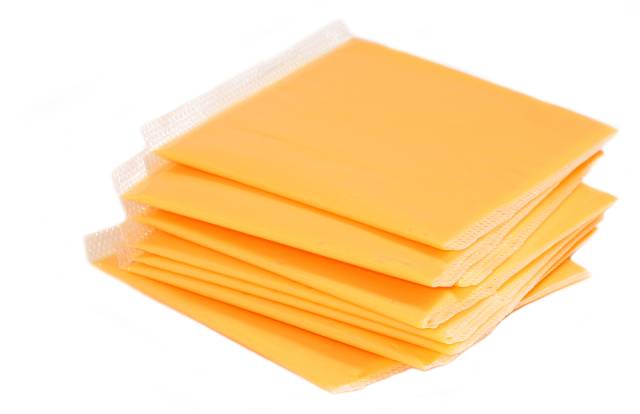
- Country of Origin: United States
- Strength: Mild
- Texture: Soft, smooth, and creamy
- Appearance: Light orange to pale yellow
- Calories: 307 kcal
- Carbohydrate: 8.9 g
- Fat: 23.1 g
- Protein: 16.1 g
‘American cheese’ is a type of cheese that almost everybody knows.
This cheese is also sometimes known as ‘slice cheese’ or ‘processed cheese,’ containing cheese with additional ingredients such as whey, milk powder, and butter.
While the exact cheese used to make American cheese can vary, it is often a mild Cheddar or cheese with similar characteristics.
American cheese has a mild taste, a kind of stretchy feel, and it melts quickly. We can find it used in cheeseburgers around the world.
Per 100 grams, American cheese has 307 calories, and it is moderately high in carbohydrates (for a cheese), fat, and protein (1).
See this guide to American cheese and its benefits and downsides for more information.
2. Asiago
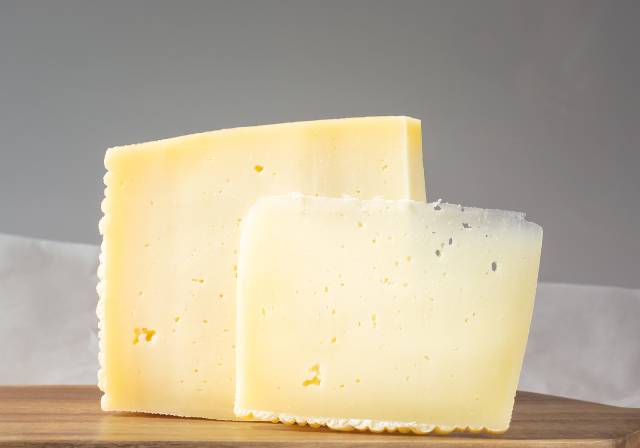
- Country of Origin: Italy
- Strength: Mild
- Texture: Semi-hard to extra hard, depending on aging time
- Appearance: Creamy light yellow, thin rind
- Calories: 400 kcal
- Carbohydrate: 3.33 g
- Fat: 30.0 g
- Protein: 26.7 g
Asiago is a semi-hard cheese from Italy that shares some characteristics with other Italian cheeses like Parmesan. In this regard, people typically use grated (aged) Asiago as a topping or flavor-enhancing ingredient in a dish.
However, fresh Asiago is quite different in terms of flavor. The cheese is mild and creamy and enjoyable to eat alone. Slices of fresh Asiago can also be used in pasta dishes, sandwiches, salads, or melted.
Nutritionally, 100 grams of Asiago contains 400 calories and provides high protein and fat content (2).
The cheese takes its name from the Asiago Plateau, a tourist attraction in the region where Asiago was produced. Fresh Asiago is known in Italian as ‘Asiago pressato’ and it is made with whole milk from low-lying pastures and aged for 20-40 days. In contrast, longer-aged Asiago is called ‘Asiago d’allevo,’ uses whole and skimmed milk from high-lying pastures, and ages from 4 months to over 15 months (3).
3. Babybel
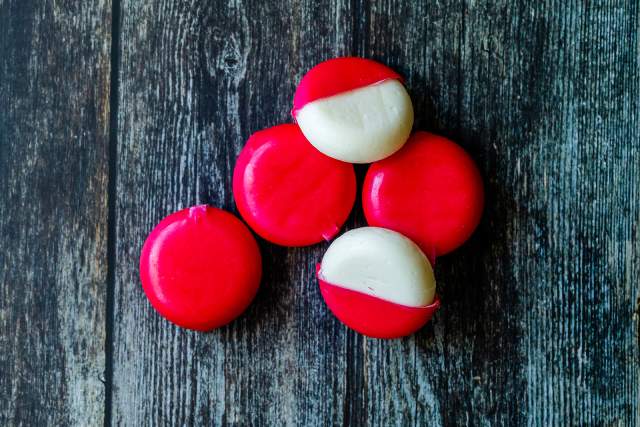
Babybel is a cheese product available in snack-sized single-serving portions.
Firstly, the original variety of Babybel is made with Edam, so it is not a unique cheese variety.
However, it is one of the most popular cheese products in the world; more than 1.5 million single portions of Babybel are produced daily (4).
Babybel also comes in a ‘light’ variety and in a wide variety of flavors.
See this complete nutritional guide to Babybel for more information.
4. Brie
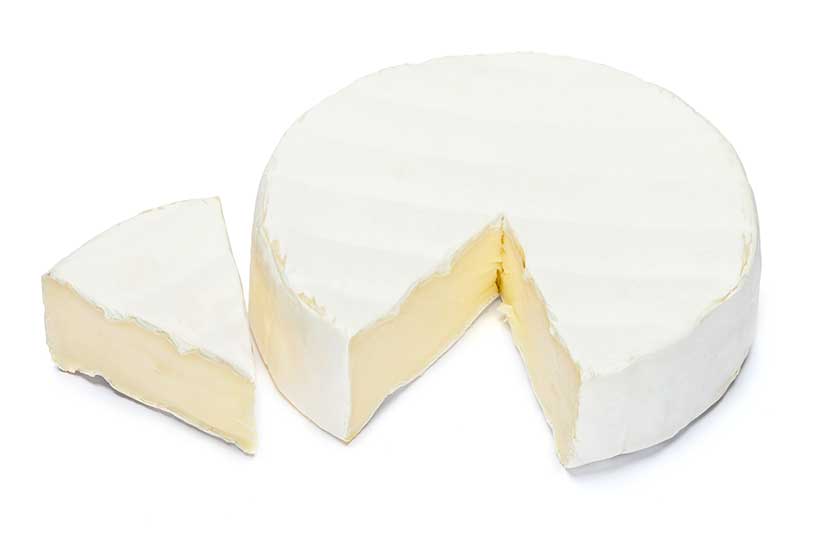
- Country of Origin: France
- Strength: Generally mild
- Texture: Soft, creamy
- Appearance: Pale yellow, white rind
- Calories: 334 kcal
- Carbohydrate: 0.5 g
- Fat: 27.7 g
- Protein: 20.7 g
Brie is a soft and creamy cheese from the region of Brie in Northern France.
The cheese has a delicious soft center surrounded by a slightly chewy rind. Brie is much milder and creamier in flavor than its cousin Camembert, and this is down to two things.
First, producers add cream to Brie before fermentation, giving the cheese a higher fat content.
Secondly, much smaller amounts of bacterial cultures (lactic acid) are added to Brie, giving it a lighter flavor.
Brie is one of the most popular cheeses globally, and it pairs well with cured ham, fruits, and wine on a cheese board.
Additionally, various recipes that involve baking Brie are becoming increasingly popular.
Brie has 334 calories per 100 grams, and it is moderately high in protein and fat (5).
5. Burrata

- Country of Origin: Italy
- Strength: Mild
- Texture: Soft and creamy
- Appearance: White, like a ball/egg
- Calories: 250 kcal
- Carbohydrate: 0 g
- Fat: 25.0 g
- Protein: 17.9 g
Burrata is a fresh Italian cheese usually made from cow milk.
While Burrata looks firm and a bit like Mozzarella from the outside, it is soft and creamy in the middle.
Nutritionally, Burrata provides a moderately high amount of fat, and it contains slightly less protein than semi-hard cheese varieties (6).
Despite being similar to Mozzarella’s texture and appearance, Burrata has a stronger and more flavorful taste.
6. Camembert
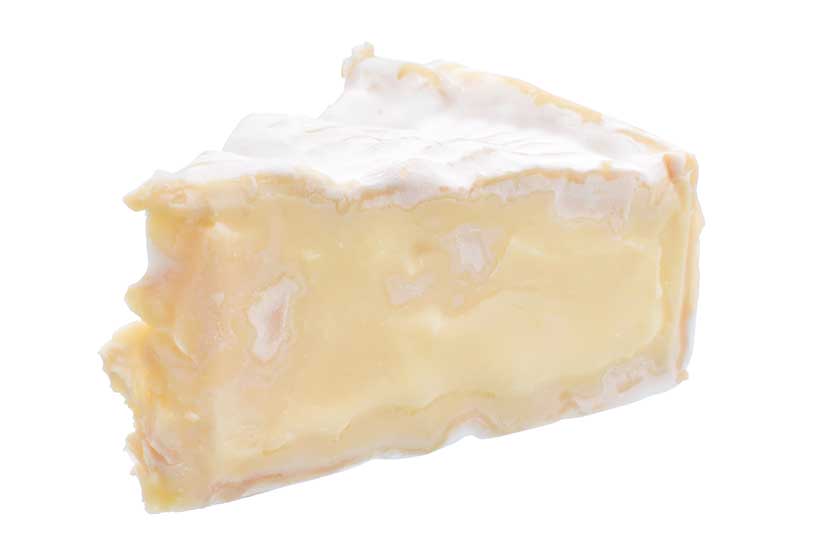
- Country of Origin: France
- Strength: Medium, pungent
- Texture: Soft, creamy
- Appearance: Pale yellow, white rind
- Calories: 300 kcal
- Carbohydrate: 0.5 g
- Fat: 24.3 g
- Protein: 19.8 g
One of the most famous cheese names in the world is Camembert.
Similar to Brie, this cheese’s origins lie in Northern France. The cheese is named after the town of Camembert, situated in the Normandy region of France.
Camembert and Brie may look the same, and although Camembert is less creamy, it makes up for this by turning up the flavor dials.
For one thing, Camembert is ripened/fermented in smaller sizes, which allows for a faster process. This process means that Camembert will age quicker (and be more pungent) than an equivalent-aged Brie.
The flavor of the two is similar, but Camembert has a more robust and deeper taste. It is much more flavorful, and sometimes it can have slightly sour notes.
Camembert also has a much more pungent smell, which puts some people off.
Every 100 grams of Camembert contains 300 calories, and the cheese is relatively high in fat and protein (7).
7. Cheddar
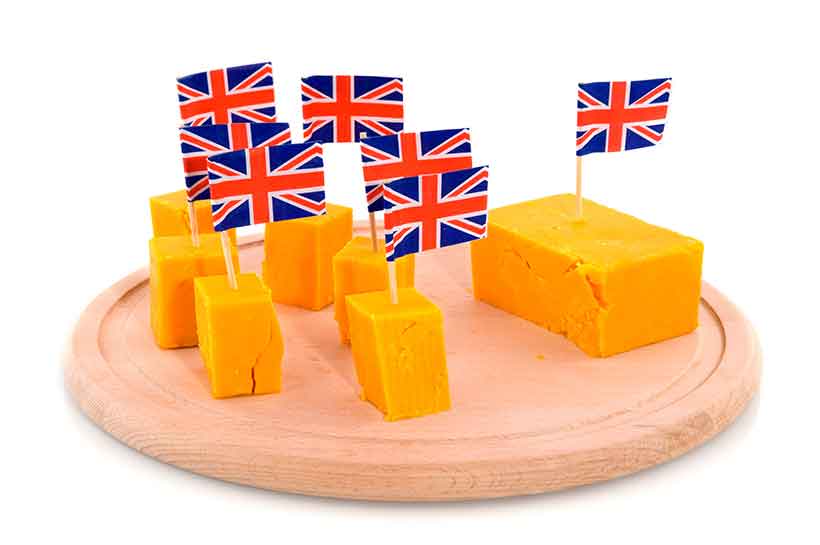
- Country of Origin: England
- Strength: Mild to pungent
- Texture: Hard
- Appearance: Pale white to orange
- Calories: 403 kcal
- Carbohydrate: 1.3 g
- Fat: 33.1 g
- Protein: 24.9 g
Possibly the most famous variety of cheese, Cheddar, comes from the village of Cheddar in Somerset, England.
There are many different kinds of Cheddar, and the cheese comes in various strengths.
According to the British Cheese Board, these different strengths of Cheddar depend on how long the cheese was aged;
- Mild: 3 months
- Medium: 5-6 months
- Mature: 9 months
- Extra Mature: 15 months
- Vintage: 18 months or older
Mild Cheddar has a soft and smooth texture and a light and almost creamy flavor.
On the other hand, vintage Cheddar is hard and crumbly and has a robust, sharp, and tangy flavor. It may also develop crunchy cheese crystals, these crystals are a result of protein breaking down, but they taste delicious.
Cheddar has 403 calories per 100 grams and provides high amounts of protein and fat (8).
8. Cheshire
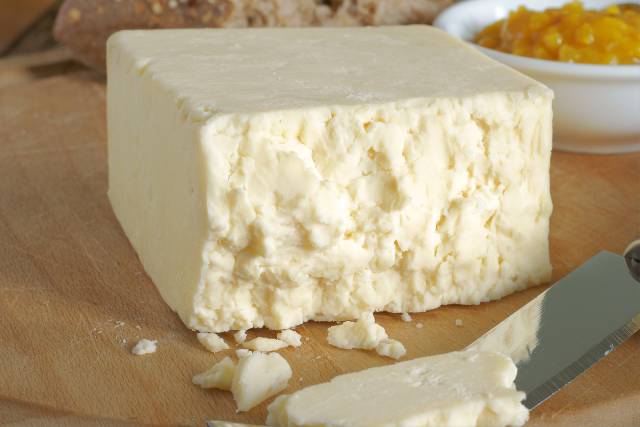
- Country of Origin: England
- Strength: Mild
- Texture: Semi-hard, crumbly
- Appearance: White to yellow, crumbly
- Calories: 387 kcal
- Carbohydrate: 4.78 g
- Fat: 30.6 g
- Protein: 23.4 g
Cheshire is a popular cheese from the Cheshire region of England, and it has a semi-hard and crumbly texture.
The taste of Cheshire is very mild. It has slightly acidic notes, and the cheese is quite salty, but the flavor is mild. For this reason, it is a good cheese to pair with foods that have stronger, more complex flavors.
People often use Cheshire cheese in recipes and for melting on top of food. While Cheshire has good melting properties, people also enjoy the cheese by itself or with fruit.
Nutritionally, 100 grams of Cheshire contains 387 calories, it is high in fat, and moderately high in protein (9).
9. Colby Jack

- Country of Origin: United States
- Strength: Mild
- Texture: Semi-hard, smooth
- Appearance: Orange and creamy white specks, marbled
- Calories: 384 kcal
- Carbohydrate: 1.62 g
- Fat: 31.2 g
- Protein: 24.1 g
Colby Jack is among the most popular cheese varieties in the United States, and it is semi-hard with a mild flavor. It has a similar taste and texture to shorter-aged varieties of Cheddar.
Interestingly, Colby Jack production involves merging two different types of cheese: Colby and Monterey Jack.
As may be apparent, Colby Jack gets its name from combining the two kinds of cheese from which it is made.
It is possible to use Colby Jack in various ways thanks to its mild flavor. However, people typically melt it on top of cooked dishes. Colby Jack also works well alone, in sandwiches and salads and for grilled toasties.
Per 100 grams, Colby Jack contains 384 calories, high amounts of dietary fat, and moderately high protein content (10).
10. Comté

- Country of Origin: France
- Strength: Mild to medium
- Texture: Semi-hard
- Appearance: Cream to light yellow with a brown crust-like rind
- Calories: 429 kcal
- Carbohydrate: 0 g
- Fat: 35.7 g
- Protein: 25.0 g
Comté is a French cheese made from unpasteurized cow milk with a mildly sweet taste.
However, the strength of the cheese can vary depending on the length of aging the cheese has undergone. This aging time can range from 4 months to over two years.
Nutritionally, Comté has a high fat content and is also relatively high in protein (11).
Comté melts well, and it is often served as a dip or melted on top of different foods.
11. Cottage Cheese
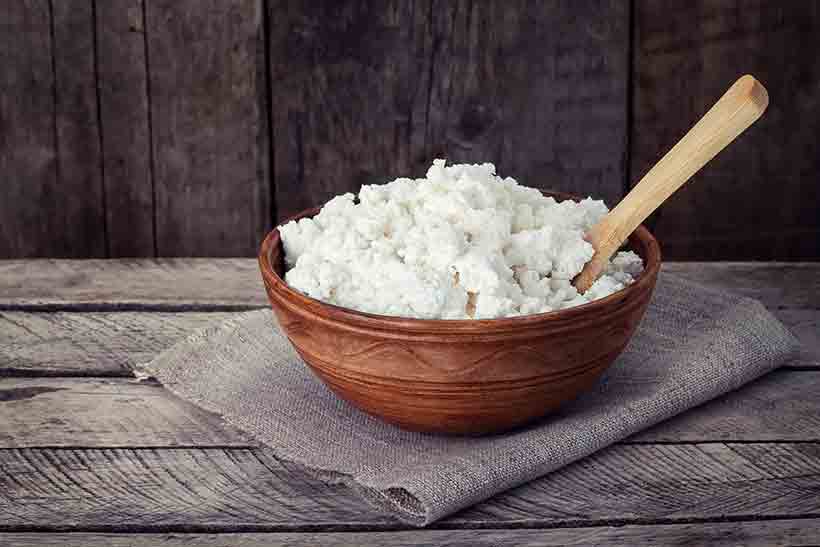
- Country of Origin: United States
- Strength: Mild
- Texture: Soft, moist and creamy
- Appearance: White curds
- Calories: 98 kcal
- Carbohydrate: 3.4 g
- Fat: 4.3 g
- Protein: 11.1 g
Cottage cheese is very different from most other varieties, and its closest relation is probably Ricotta.
This famous cheese is made by acidifying curds from milk with a bacterial starter culture.
Due to the different production processes, the nutrition profile is very different from other types of cheese. It has a very low fat content and is much lower in calories.
As a result, cottage cheese is beneficial for those wanting a more protein-dense option.
On the negative side, some people find the appearance of cottage cheese off-putting. They may have a point because the lumpy texture resembles cold rice pudding.
However, it does taste good, and it has a mild, salty, and creamy taste.
We can also use it in various recipes, such as these delicious cottage cheese pancakes.
One hundred grams of cottage cheese will provide 98 calories; it is low in carbohydrates and fat and moderately high in protein (12).
The solid form of curds, known simply as ‘cheese curds,’ is another popular form of cheese.
12. Cream Cheese
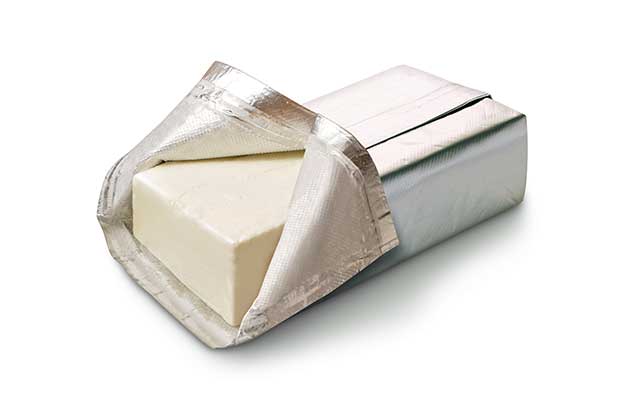
- Country of Origin: United Kingdom
- Strength: Mild, slightly sweet
- Texture: Soft and creamy
- Appearance: White spread
- Calories: 350 kcal
- Carbohydrate: 5.52 g
- Fat: 34.4 g
- Protein: 6.15 g
Although cream cheese may seem like a more recent cheese product, it has hundreds of years of history.
The first known mentions of the cheese go back to 1583, making cream cheese almost 500 years old.
Cream cheese comes in different varieties and flavors, and it tastes delicious, either plain or with additional seasonings like garlic and chives.
Nutritionally, cream cheese is quite different from hard and semi-hard types of cheese. It has a much higher fat content and less protein.
For more information and some recipe ideas, see this guide to cream cheese.
Per 100 grams, cream cheese provides 350 calories. It is also relatively low in carbohydrates and protein but has a very high fat content (13).
13. Danish Blue
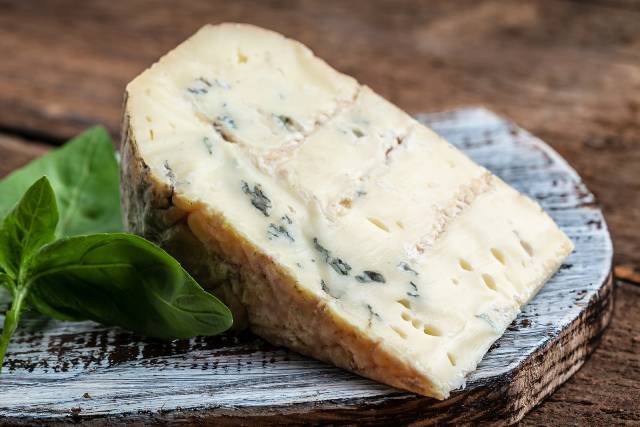
- Country of Origin: Denmark
- Strength: Strong
- Texture: Soft to firm, smooth
- Appearance: White with internal blue veins
- Calories: 357 kcal
- Carbohydrate: 0 g
- Fat: 28.6 g
- Protein: 24.1 g
Danish Blue is a blue-veined cheese from Denmark with strong and complex flavors.
On this note, Danish Blue may not be the best option for those who like mild cheese.
Among its characteristics, Danish Blue has a strong, pungent smell, and a rich, flavorful, and salty taste. However, it is not quite as strong as some other blue cheese options, such as Roquefort.
Many people like to melt Danish Blue into a dish to give the food a more complex, enhanced flavor. It can also work well as a melted topping or crumbled into salads.
Nutritionally, 100 grams of Danish Blue contains 357 calories, it is high in fat, and it provides a moderately high amount of protein (14).
14. Edam
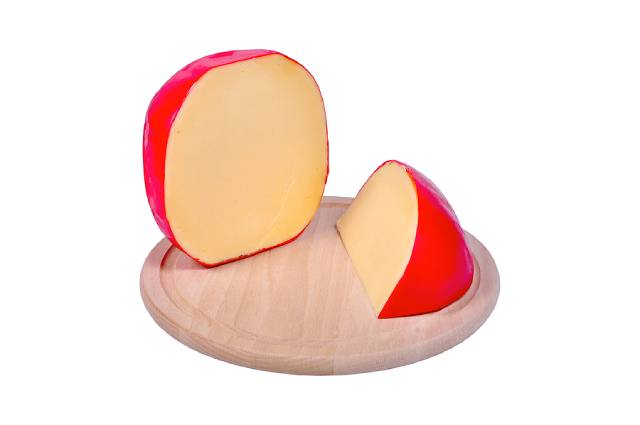
- Country of Origin: Denmark
- Strength: Mild
- Texture: Semi-hard
- Appearance: Creamy yellow and smooth with a red wax skin
- Calories: 357 kcal
- Carbohydrate: 1.43 g
- Fat: 28.6 g
- Protein: 25.0 g
Edam is one of the most famous kinds of cheese in the world with centuries of history (15)
This Dutch cheese has a semi-hard texture and a mild and creamy flavor. Edam is enjoyable to eat by itself, and it can be used in many different foods due to its mild, versatile flavor.
Edam takes its name from the town of Edam, where it was first produced. The cheese can also have stronger, more complex flavors depending on the aging time.
Per 100 grams, Edam contains 357 calories and is high in protein and fat (16).
15. Emmental

- Country of Origin: Switzerland
- Strength: Mild
- Texture: Semi-hard, smooth
- Appearance: Creamy yellow with large holes
- Calories: 396 kcal
- Carbohydrate: 1.5 g
- Fat: 31.4 g
- Protein: 27.1 g
Emmental is a Swiss-style cheese characterized by a gentle, mild flavor and a smooth texture (aside from the large holes).
For more on Swiss cheese, see this complete guide:
12 Varieties of Swiss Cheese and Their Nutritional Properties
The cheese originated in Emmental, which is a region in Switzerland. Emmental has a slightly creamy and fruity taste, and it is enjoyable to eat by itself.
Emmental also has excellent melting properties, so it often features in pasta and pizza dishes and grilled cheese toasties.
Per 100-gram serving, Emmental provides large amounts of dietary fat and protein, and it contains 396 calories (17).
16. Epoisses
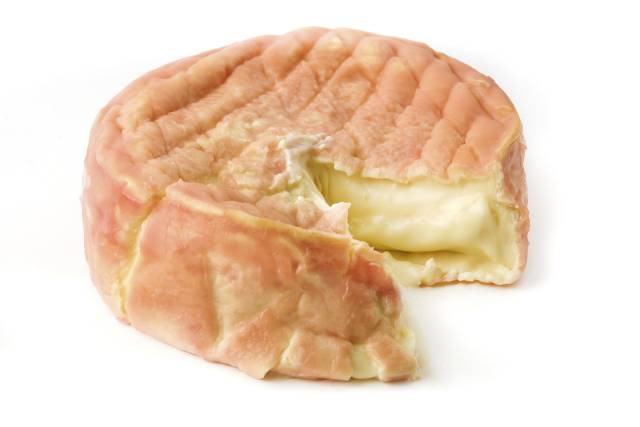
- Country of Origin: France
- Strength: Strong, pungent
- Texture: Soft
- Appearance: White flesh and bronzed orange rind
- Calories: 290 kcal
- Carbohydrate: 1.0 g
- Fat: 24.0 g
- Protein: 17.0 g
Epoisses is a highly flavorful French cheese with a powerful smell.
The cheese is a washed-rind cheese that looks slightly similar to Brie and Camembert, but it has a darker orange-colored rind.
As well as being flavorful, the cheese is very soft and creamy.
Most produced Epoisses cheese is unpasteurized. However, only pasteurized versions of Epoisses are sold in the United States due to food safety laws.
Epoisses contains 290 calories per 100 grams; it is high in fat and a moderately high source of protein (18).
17. Feta Cheese
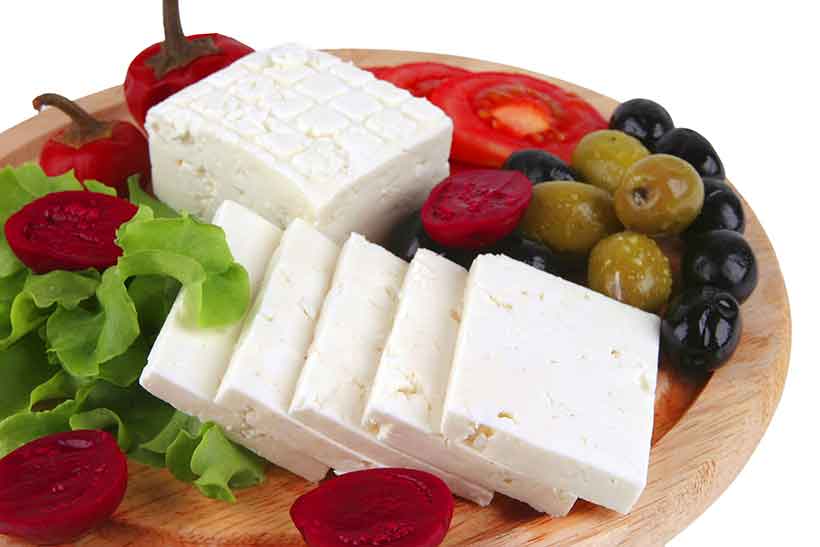
- Country of Origin: Greece
- Strength: Mild
- Texture: Soft and crumbly
- Appearance: Pale, white curd
- Calories: 265 kcal
- Carbohydrate: 3.88 g
- Fat: 21.5 g
- Protein: 14.2 g
Feta is a famous Greek cheese made from either sheep or sheep and goat’s milk.
Unlike many other kinds of cheese, Feta is not named after its place of origin, and “Feta” actually means “slice” in English.
Feta has quite a unique taste, and it is very soft and creamy with a salty and tangy taste. However, the flavor can vary greatly depending on how it is prepared or cooked.
For instance, there are many ways to serve Feta; it can be grilled, eaten raw in a salad, or marinated in olive oil and several herbs.
Feta cheese has a couple of specific health benefits too;
- Since Feta uses sheep or goat’s milk, it may be suitable for those who have sensitivities to cow’s milk
- Feta is lower in fat and calories than hard forms of cheese, despite also offering an impressive range of nutrients. As a result, it is very nutrient-dense.
Feta is available either in a block or in “crumbled” form, and it is usually packed in a brine solution.
One hundred grams of Feta provides 265 calories and is a moderate protein and fat source (19).
18. Fontina
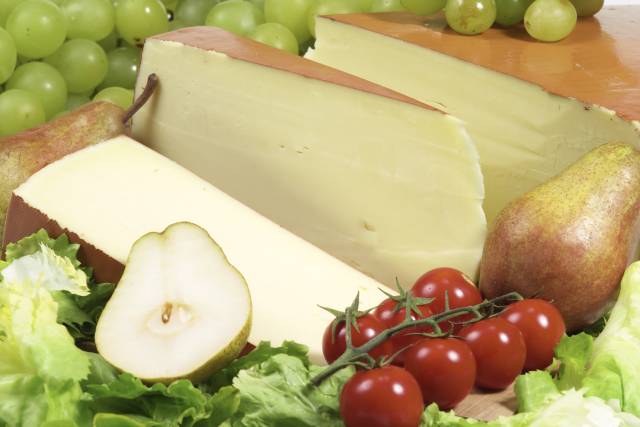
- Country of Origin: Italy
- Strength: Light and mild
- Texture: Semi-hard
- Appearance: Creamy to pale yellow with a browny rind
- Calories: 389 kcal
- Carbohydrate: 1.55 g
- Fat: 31.1 g
- Protein: 25.6 g
Fontina is another famous Italian cheese with a semi-soft texture.
Although the cheese is relatively mild in flavor, it has slightly nutty and fruity tones, and it is enjoyable to eat.
Since Fontina is very soft and melts well, it is a good cheese for use in the kitchen. For example, it works well as a topping for pizza, in toasted sandwiches, and sprinkled on the top of oven-cooked dishes.
Per 100 grams, Fontina has 389 calories, and it is low in carbohydrates and high in fat and protein (20).
19. Gjetost
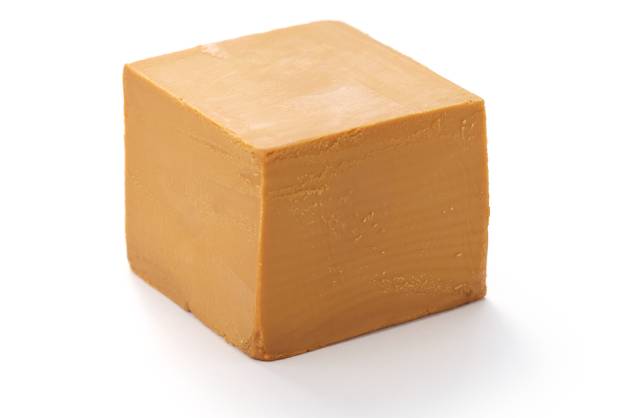
- Country of Origin: Norway
- Strength: Mild, creamy, sweet
- Texture: Firm, caramel-like
- Appearance: Smooth, creamy, caramel-like
- Calories: 466 kcal
- Carbohydrate: 42.6 g
- Fat: 29.5 g
- Protein: 9.65 g
Gjetost is a type of brown cheese from Norway, and it may also be referred to as Brunost.
This Norwegian cheese has interesting flavors, and due to the production process, it tastes sweet and creamy.
On this note, Gjetost production involves boiling milk, cream, and whey until all the water content evaporates, leaving concentrated (and subsequently caramelized) milk sugars.
After the milk sugars caramelize, Gjetost is refrigerated, and it gets a firm texture as it cools.
Based on archaeological findings, Gjetost’s history may go back to 650 BC (21).
Unlike most cheese, Gjetost provides a substantial amount of carbohydrates due to its sugar content. Per 100 grams, it contains 466 calories and high levels of carbohydrates and fat, with a smaller amount of protein (22)
20. Gorgonzola
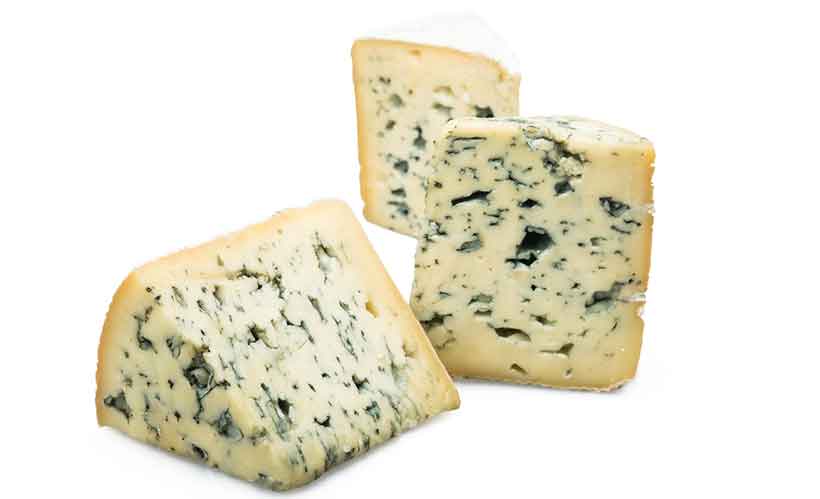
- Country of Origin: Italy
- Strength: Sharp, strong
- Texture: Soft to firm depending on age
- Appearance: Pale yellow, white skin
- Calories: 353 kcal
- Carbohydrate: 2.3 g
- Fat: 28.7 g
- Protein: 21.4 g
Gorgonzola is a robust cheese from Italy that packs a big flavor.
There are two primary varieties of this cheese; Dolce and Piccante.
Typically aged for less than three months, Dolce Gorgonzola is soft, creamy, and almost spreadable cheese.
For blue cheese, it is deceptively mild and has a slightly sweet flavor. However, the key words there are “for blue cheese” – Dolce Gorgonzola is still sharp and intense compared to other cheeses.
On the other hand, Piccante Gorgonzola ages six to twelve months, and the extra aging time is apparent when you first taste it.
The texture is semi-hard and crumbly, and the flavor is intense. For this reason, it is better paired with food rather than eaten alone.
Gorgonzola has 353 calories per 100 grams, and it offers high amounts of protein and fat (23).
21. Gouda

- Country of Origin: Netherlands
- Strength: Mild to strong
- Texture: Semi-hard
- Appearance: Light to dark yellow
- Calories: 356 kcal
- Carbohydrate: 2.2 g
- Fat: 27.4 g
- Protein: 24.9 g
Gouda is a Dutch cheese from the town of Gouda in the Southern Netherlands.
Interestingly, the taste, texture, and flavor of Gouda can vary a lot.
Due to the vast differences in aging time (anywhere from 1 month to 36 months), two different types of Gouda can taste entirely different.
Younger cheeses are mild in flavor with a smooth, semi-hard texture; older Gouda is hard and crumbly, with a deeper flavor.
Similar to Cheddar, Dutch cheesemakers classify Gouda by six different grades, depending on the age;
- Young cheese: 4 weeks
- Young matured: 8-10 weeks
- Matured: 16-18 weeks
- Extra matured: 7-8 months
- Old cheese: 10-12 months
- Very old cheese: 12 months +
A typical Gouda has 356 calories per 100 grams, and it provides high amounts of fat and protein (24).
22. Gruyère
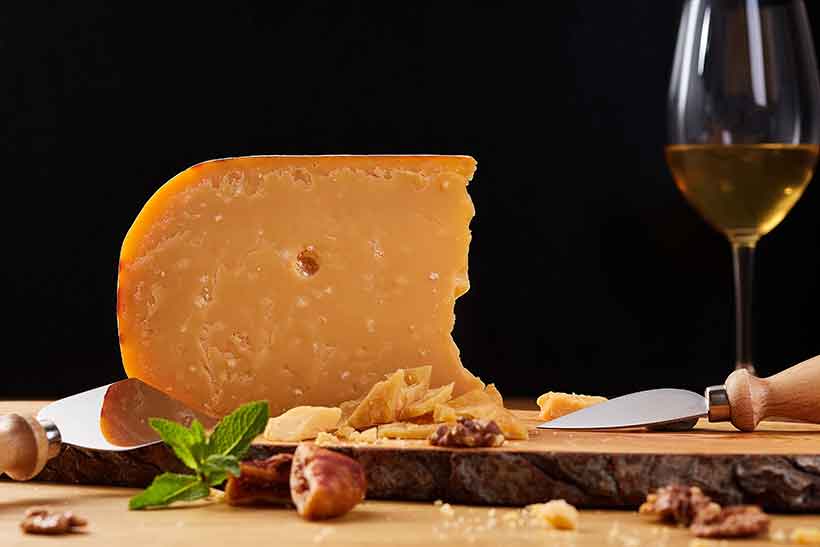
- Country of Origin: Switzerland
- Strength: Mild to strong
- Texture: Hard
- Appearance: Cream to orange
- Calories: 413 kcal
- Carbohydrate: 0.4 g
- Fat: 32.3 g
- Protein: 29.8 g
Gruyère is a Swiss cheese from the medieval town of Gruyères in Fribourg, Switzerland.
It is a hard cheese with a dense, compact texture and a good depth of flavors.
Gruyère ages between 6 months and a year, and this longer aging time is responsible for the harder texture. In addition, as the cheese matures, so too does the flavor.
Gruyère can be eaten alone, but it is often used for culinary purposes and makes a delicious grated topping on many foods. It is also a common ingredient in toasted sandwiches, and various French soups and stews use it.
Gruyère typically provides 413 calories per 100 grams, and it contains more fat and protein than most other types of cheese (25).
23. Halloumi
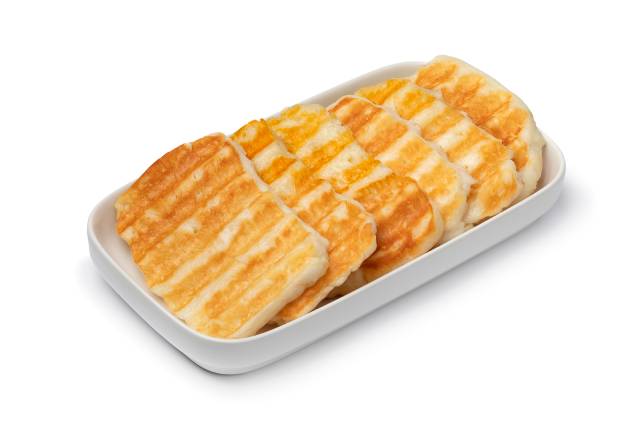
- Country of Origin: Cyprus
- Strength: Mild to strong, salty
- Texture: Semi-hard, chewy, firm, rubbery
- Appearance: Pale white to light yellow
- Calories: 311 kcal
- Carbohydrate: 1.7 g
- Fat: 23.5 g
- Protein: 23.9 g
As shown above, Halloumi contains 311 calories per 100 grams, and it is rich in fat and protein (26).
Halloumi is an interesting Cypriot variety of cheese usually cooked before eating.
The reason is that the cheese has a high melting point, meaning that it can be fried or grilled without melting. Compared to other cheeses, Halloumi contains more sodium, so it has a somewhat salty taste.
Another unique characteristic of Halloumi is that it has a somewhat rubbery texture and feels like it is squeaking when chewed.
Most Halloumi is made from goat and sheep milk.
See this full guide to Halloumi for more information.
24. Havarti
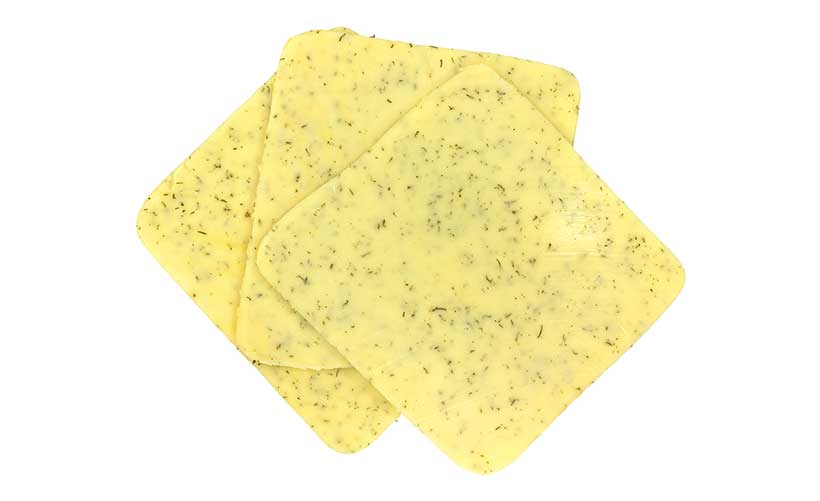
- Country of Origin: Denmark
- Strength: Mild to sharp
- Texture: Semi-hard, creamy
- Appearance: Pale yellow with “eyes”
- Calories: 393 kcal
- Carbohydrate: 3.6 g
- Fat: 32.1 g
- Protein: 21.4 g
Havarti is a semi-soft Danish table cheese, and it provides 393 calories per 100 grams. It is also very high in fat and moderately rich in protein (27).
Like all cheeses, the flavor of Havarti develops as it ages; young Havarti has a mild, buttery texture and a slightly tangy taste. In contrast, older varieties are still smooth and creamy but taste sharper with a salty and robust flavor.
However, the typical aging process of Havarti lasts for around three months.
Havarti makes a great pairing with wine, cured meat, and fruit, and many people like to grill it.
25. Jāni
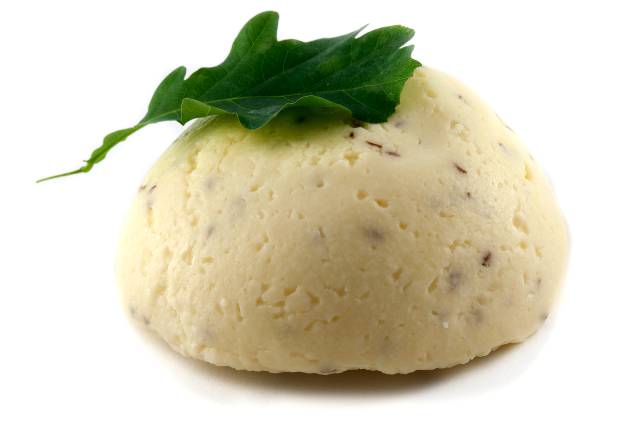
- Country of Origin: Latvia
- Strength: Mild
- Texture: Soft
- Appearance: White to creamy yellow with black specks (caraway seeds), round, spongey
- Calories: 376 kcal
- Carbohydrate: 3.06 g
- Fat: 29.2 g
- Protein: 25.2 g
Also known as ‘janu’ or ‘caraway,’ Jani is a fresh, mild-tasting cheese flavored with caraway seeds.
Jani comes from Latvia, and it has the shape of a small circular wheel with a soft and spongey texture.
In addition to caraway seeds, additional ingredients including butter, cream, and eggs may be added to Jani during its production.
Unlike many cheese varieties, making Jani from home is simple as it only involves heating whole milk with curds. There is a recipe explaining how to make it here.
Per 100 grams, caraway cheese contains 376 calories, and it is high in both protein and fat (28).
26. Jarslberg
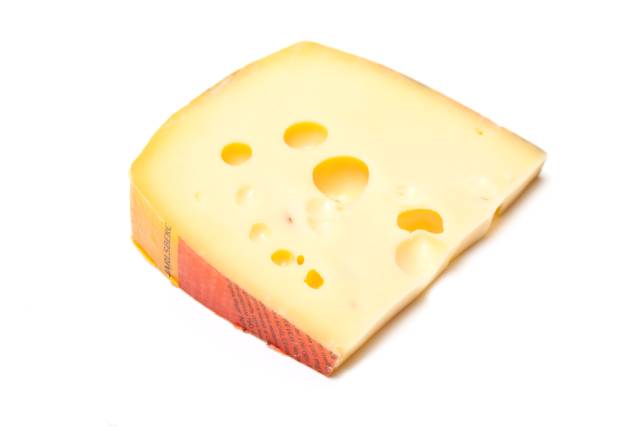
- Country of Origin: Norway
- Strength: Mild
- Texture: Semi-hard
- Appearance: Pale yellow with large holes throughout
- Calories: 351 kcal
- Carbohydrate: 0 g
- Fat: 27 g
- Protein: 27 g
Jarlsberg is a famous Norwegian cheese with a mild and nutty flavor.
The cheese has an attractive appearance thanks to its large holes throughout, and it’s one of the best-tasting cheese options.
One of the best things about Jarlsberg is the versatility of the cheese, and its texture and flavor work well in a wide range of different dishes.
Since Jarlsberg melts quickly, it is often used for making fondue and cheese dip products.
Per 100 grams, Jarlsberg contains 351 calories and high amounts of protein and fat (29).
Find out more about Jarlsberg in this complete guide.
27. Laughing Cow
Laughing cow is one of the world’s most popular varieties of processed cheese.
This popular snack-sized cheese comes in packs of individually foil-wrapped triangular-shaped pieces.
The cheese comes in several different varieties, each of which have their own distinct taste and nutritional profile.
For a comprehensive guide to the Laughing Cow cheese, see the following guide:
Is The Laughing Cow Cheese Healthy?
28. Limburger

- Country of Origin: Belgium/Germany/Netherlands
- Strength: Mild, creamy
- Texture: Soft to semi-hard
- Appearance: Smooth, creamy, pale yellow
- Calories: 327 kcal
- Carbohydrate: 0.49 g
- Fat: 27.2 g
- Protein: 20.0 g
Limburger is a soft and creamy cheese with origins in what is now known as the Liege region of Belgium. However, this historic origin region was called the Duchy of Limburg, spread across modern-day Belgium, Germany, and the Netherlands (30).
Traditionally, people use Limburger as a sandwich filling. It could also be eaten as part of a cheese platter with nuts and fruit.
Despite its mild appearance, Limburger has a robust and complex flavor and a pungent smell.
Per 100 grams, Limburger contains 327 calories and moderately high amounts of protein and fat, with minimal carbohydrate content (31).
29. Manchego
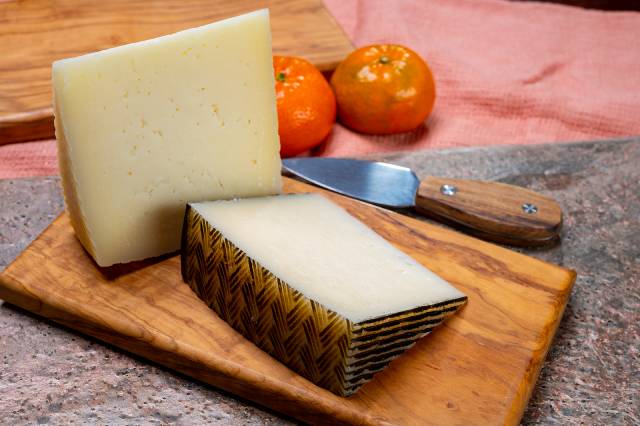
- Country of Origin: Spain
- Strength: Medium (but varies by age)
- Texture: Hard
- Appearance: Pale white to yellow
- Calories: 455 kcal
- Carbohydrate: 0 g
- Fat: 39.3 g
- Protein: 25.0 g
Manchego is a delicious Spanish cheese made from sheep’s milk. It has a hard texture, and it is very creamy due to its high fat content.
On this note, Manchego has one of the highest fat (39.3g) and calorie (464 kcals) contents among popular cheese varieties (32).
Although Manchego has a distinct, slightly sharp, and sweet taste, it is still relatively mild and easy to eat alone.
Manchego is the most popular cheese in Spain, and its origins may go back thousands of years.
30. Manouri
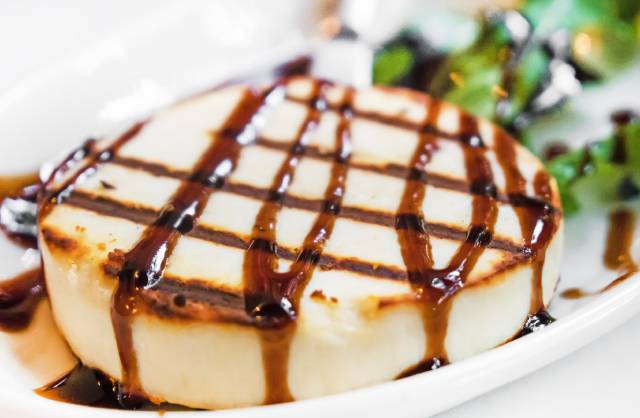
- Country of Origin: Greece
- Strength: Light and mild
- Texture: Semi-hard
- Appearance: Creamy white
- Calories: 321 kcal
- Carbohydrate: 7.1 g
- Fat: 28.6 g
- Protein: 17.8 g
Manouri is a fresh semi-soft cheese from Greece with a light and creamy texture.
It shares some similarities with Feta and could be called a creamier version. However, it has a less salty taste as it does not come packed in brine.
Cream is added to Manouri during the production process, which contributes to the taste, and gives the cheese a relatively high fat content.
Per 100 grams, Manouri cheese has 321 calories, and it is low in carbohydrates, high in fat, and relatively high in protein (33).
Manouri can be used in numerous ways, whether in savory meals or dessert recipes.
31. Mascarpone
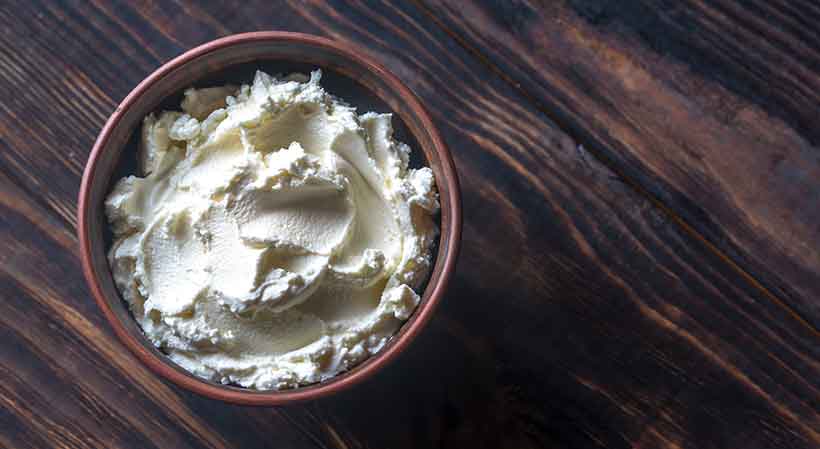
- Country of Origin: Italy
- Strength: Very mild
- Texture: Soft, creamy
- Appearance: Thick, white, creamy
- Calories: 429 kcal
- Carbohydrate: 0 g
- Fat: 46.4 g
- Protein: 7.1 g
Mascarpone is a soft cream cheese from Italy and can be made with cow’s milk or cream.
Notably, it is a fresh cheese and does not undergo fermentation,
Mascarpone has many uses, and it spreads easily like standard cream cheese.
Popular foods that use Mascarpone include the Italian desserts tiramisu and risotto, and many cheesecakes use it.
Mascarpone is a creamy white color, and it looks similar to yogurt or a thicker version of sour cream.
Mascarpone has a delicious light, creamy, and very mild taste.
Some people say it is a more flavorful version of cream.
Nutritionally, 100 grams of Mascarpone provides 429 calories, moderate protein, and significant amounts of fat (34).
32. Monterey Jack
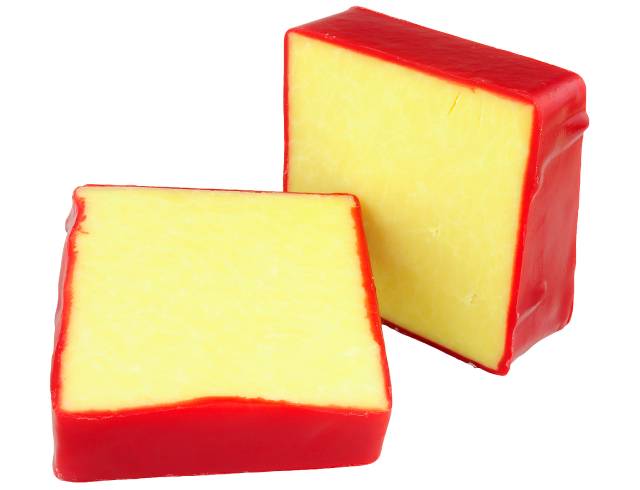
- Country of Origin: United States
- Strength: Mild
- Texture: Semi-hard
- Appearance: Creamy white to mild yellow
- Calories: 373 kcal
- Carbohydrate: 0.7 g
- Fat: 30.0 g
- Protein: 24.5 g
Monterey Jack is one of the most popular cheese options in the United States.
It has a mild flavor, a light creamy color, and melts well, making it suitable for various uses.
The cheese is made from cow’s milk and has a semi-hard texture.
According to the ‘true story of Monterey Jack,’ this famous cheese first originated in the 1700s.
Per 100 grams, Monterey Jack has 373 calories and high amounts of protein and fat (35).
33. Mozzarella
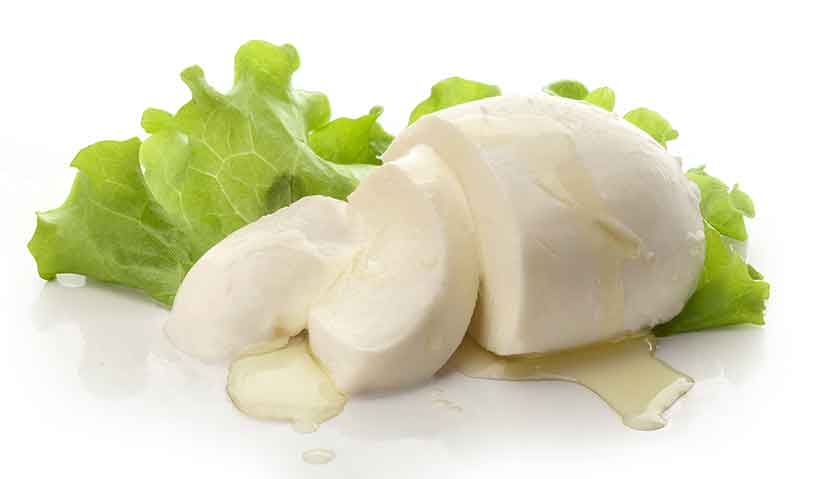
- Country of Origin: Italy
- Strength: Mild
- Texture: Firm, chewy
- Appearance: Creamy white
- Calories: 318 kcal
- Carbohydrate: 2.5 g
- Fat: 24.6 g
- Protein: 21.6 g
Mozzarella is one of the best-known cheeses in the world.
It originates from Southern Italy, traditionally made from Italian Buffalo’s milk. However, Mozzarella from cow, goat, and sheep’s milk has been produced in recent times.
Mozzarella comes in two main varieties; fresh and dried.
The fresh version is delicious alone or with some olive oil and herbs. It is also a frequent ingredient in various salads.
This fresh version provides 318 calories and high amounts of protein and fat per 100 grams (36).
In contrast to the fresh variety, dried Mozzarella is mostly for culinary purposes. It is a common ingredient in sandwiches and toasties as well as pasta and pizza.
34. Muenster
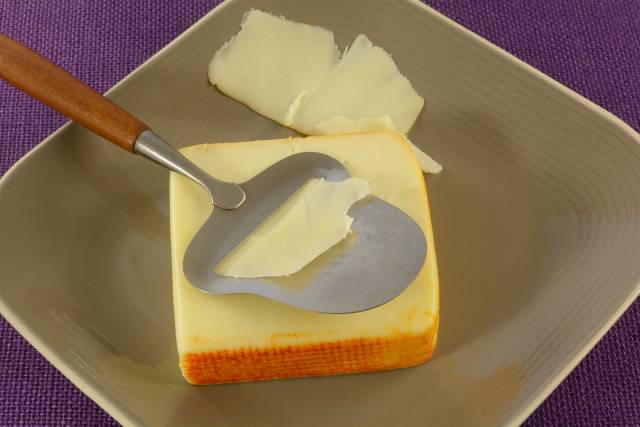
- Country of Origin: United States
- Strength: Mild
- Texture: Semi-hard
- Appearance: Pale yellow with a thick orange rind
- Calories: 368 kcal
- Carbohydrate: 1.12 g
- Fat: 30.0 g
- Protein: 23.4 g
Muenster is a semi-soft cheese from the United States. The cheese is made with cow milk, and it has a mild and enjoyable flavor.
While the name sounds European, Muenster is believed to be based on Munster cheese from France. However, it is one of the earliest varieties of cheese to originate in the United States, in the 1800s (24).
Muenster is another cheese that melts well. As a result, it tends to be a good fit for grilled cheese sandwiches, cheese toppings, and various other dishes.
Per 100 grams, Muenster cheese has 368 calories, and it is high in both protein and fat (37).
35. Myzithra
- Country of Origin: Greece
- Strength: Mild
- Texture: Soft (but varies depending on aging)
- Appearance: White to creamy color
- Calories: 286 kcal
- Carbohydrate: 7.14 g
- Fat: 21.4 g
- Protein: 14.3 g
Myzithra, also known as Mizithra, is a Greek cheese made from sheep or goat milk.
It is most often produced as a soft, fresh cheese with a mildly sweet flavor. However, longer aged, harder varieties of Myzithra also exist.
The fresh variety of Myzithra contains no salt, making it a good option for individuals watching their sodium intake.
Myzithra can be used for both savory dishes and in desserts, and its mild flavor can adapt to various recipes.
Nutritionally, 100 grams of Myzithra provides 286 calories, and it is moderately high in carbohydrates for a cheese. Myzithra has a relatively high fat content and is a moderate source of protein (38).
36. Paneer
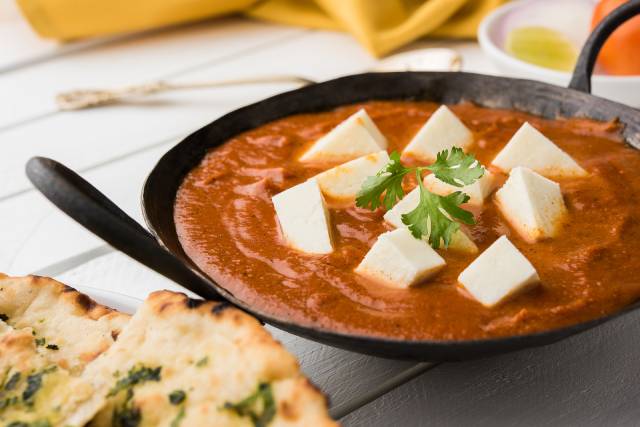
- Country of Origin: India
- Strength: Mild
- Texture: Soft, spongy
- Appearance: Creamy white
- Calories: 365 kcal
- Carbohydrate: 3.6 g
- Fat: 29.0 g
- Protein: 22.0 g
Paneer is a fresh variety of cheese from India usually served in small cubes.
The appearance and texture of Paneer somewhat resemble tofu, mainly when used in cooked dishes.
Paneer is very similar to cottage cheese in how its made and its overall characteristics. However, Paneer is not salted, and it has a firmer texture.
It is also quite bland alone, which lends itself to the wide variety of recipes paneer features in. In India, Paneer is often eaten after being spiced or used in curries like this one.
Paneer contains 365 calories and large amounts of fat and protein per 100 grams (39).
37. Parmigiano-Reggiano (Parmesan)
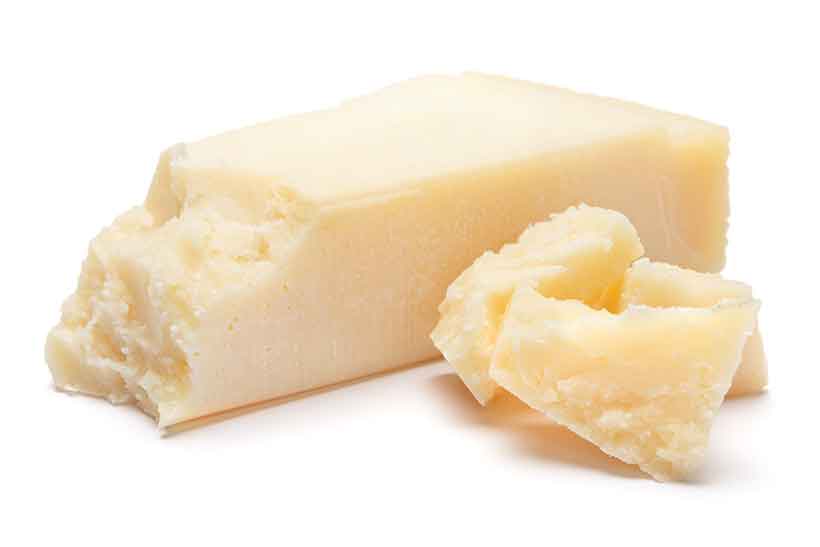
- Country of Origin: Italy
- Strength: Medium to strong (depending on age)
- Texture: Extra hard, crumbly, granular
- Appearance: Pale yellow
- Calories: 392 kcal
- Carbohydrate: 3.22 g
- Fat: 25.0 g
- Protein: 35.8 g
Parmigiano-Reggiano (also known as Parmesan) is a dry, crumbly, hard cheese with a strong, robust flavor.
Notably, Parmesan is one of the most protein-rich cheese options, containing 35.8 grams of protein per 100 grams (40).
People often refer to the cheese as Parmesan, and it has a protected designation of origin (POD status). This designation means that the cheese can only be from its home region in Northern Italy.
Parmesan usually comes in unpasteurized form, and it undergoes an aging time of between one and three years.
Consequently, it is rich in flavor and can be overpowering when eaten alone.
Usually, Parmesan is used as a condiment for various dishes and may come in a granular, powdery form.
38. Pecorino Romano
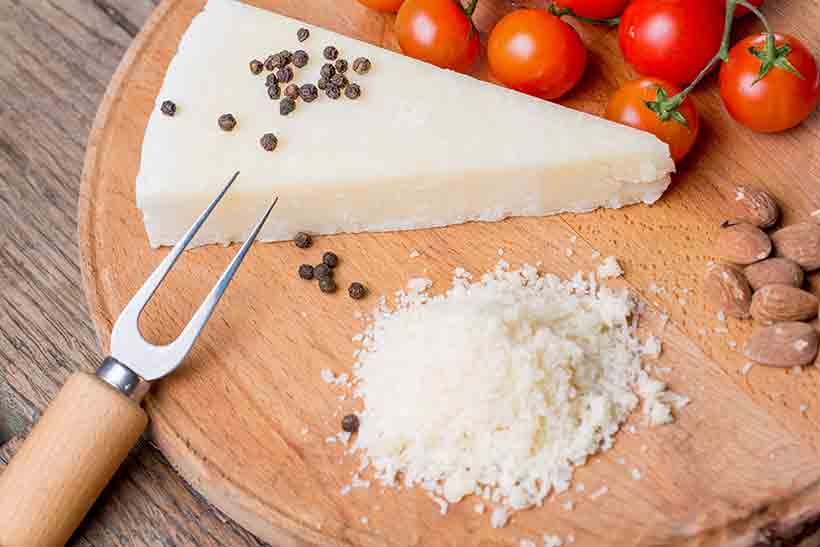
- Country of Origin: Italy
- Strength: Strong, sharp
- Texture: Extra hard and crumbly
- Appearance: Pale yellow
- Calories: 393 kcal
- Carbohydrate: 3.57 g
- Fat: 32.1 g
- Protein: 28.6 g
Pecorino Romano is one of the world’s oldest (and favorite) cheeses, and when you taste it, it is easy to understand why.
The cheese goes back to Roman times, and it was part of the staple diet for Roman legions.
Pecorino Romano uses sheep’s milk, and it is very hard and salty. It is very similar to Parmesan, but it tastes much saltier and sharper.
For those who appreciate intense flavors, Pecorino Romano is an excellent choice. However, those looking for something less powerful might want to try Parmesan.
Pecorino Romano should not be confused with generic ‘Romano’ cheeses in the North Americas. These cheeses use cow’s milk and are much milder in intensity.
Per 100 grams, Pecorino Romano provides 393 calories and significant amounts of fat and protein (41).
39. Provolone
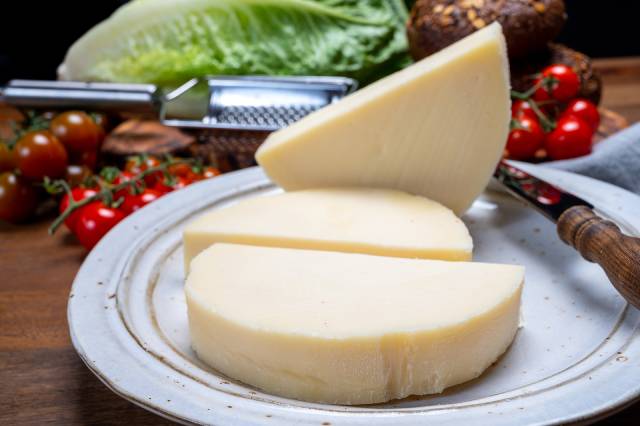
- Country of Origin: Italy
- Strength: Medium (varies by age)
- Texture: Semi-hard
- Appearance: Creamy in color
- Calories: 351 kcal
- Carbohydrate: 2.1 g
- Fat: 26.6 g
- Protein: 25.6 g
Provolone is a popular Italian cheese that can vary from mild and light to strong and sharp, depending on the production and aging time.
The cheese originated in Southern Italy in the 1800s, and it is made with cow’s milk.
It is also possible to buy smoked provolone cheese, which has an extra rich and smoky flavor.
One hundred grams of Provolone cheese has 351 calories, low amounts of carbohydrates, and more than 25 grams of fat and protein (42).
See here for a full nutritional breakdown of provolone
40. Queso Blanco
- Country of Origin: Mexico/Latin America
- Strength: Mild, creamy
- Texture: Soft
- Appearance: Soft, creamy, white
- Calories: 310 kcal
- Carbohydrate: 2.53 g
- Fat: 24.3 g
- Protein: 20.4 g
‘Queso blanco’ refers to many varieties of white cheese produced in Latin America and translates to ‘white cheese’ in English (43).
These queso blanco cheeses are fresh cheese that is often homemade, produced by acidifying milk with vinegar, forming curds, and then draining the curds (43).
Among their uses, queso blanco cheeses can be used in various pot dishes or eaten alone.
The typical nutritional profile of queso blanco provides 310 calories and moderate amounts of fat and protein on a per-100-gram basis (44).
41. Red Leicester
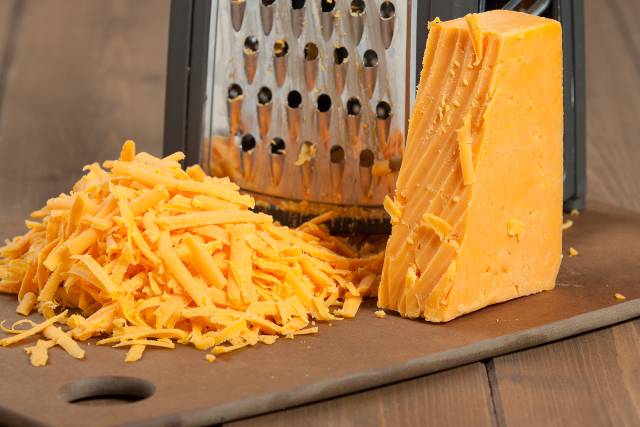
- Country of Origin: England
- Strength: Mild-medium
- Texture: Semi-hard to hard
- Appearance: Orange, firm, slightly crumbly
- Calories: 393 kcal
- Carbohydrate: 1.79 g
- Fat: 35.7 g
- Protein: 25.0 g
Red Leicester is a popular English cheese characterized by its bright orange color.
However, the color of this cheese is achieved through the use of a coloring called annatto.
Most Red Leicester has a relatively mild taste, but some longer-aged versions can have a sharper, tangy flavor, similar to aged Cheddar.
The name of the cheese comes from the cheese’s origin; the Leicestershire region of England.
Nutritionally, 100 grams of Red Leicester provides 393 calories and significant fat content, with a moderately high amount of protein (45).
42. Ricotta
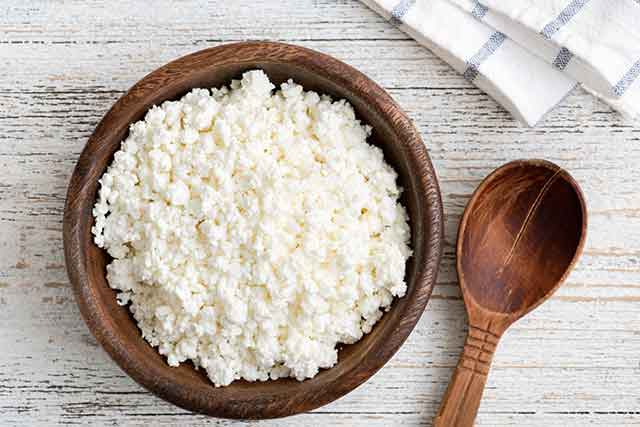
- Country of Origin: Italy
- Strength: Mild, slightly sweet
- Texture: Soft, creamy
- Appearance: Curds, white/light cream color
- Calories: 148 kcal
- Carbohydrate: 6.0 g
- Fat: 9.46 g
- Protein: 9.6 g
Ricotta is a soft, fresh Italian cheese made from whey.
Per 100 grams, Ricotta contains 148 calories and moderate amounts of carbohydrate, fat, and protein (46).
This cheese has a mild, slightly sweet, and creamy texture, and it is one of the most popular types of cheese in the world.
Ricotta has some excellent nutritional benefits too. For one thing, particularly the low-fat version of Ricotta is significantly lower in calories than most other cheese options, and it is an excellent source of protein.
These low-fat versions of Ricotta are very popular with athletes and bodybuilders due to their impressive protein density.
For a detailed review, see this guide to the nutrition benefits of Ricotta.
43. Roquefort
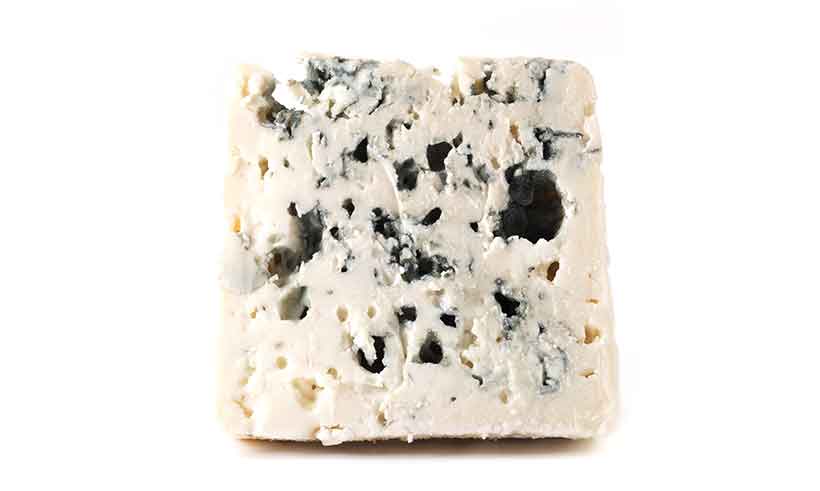
- Country of Origin: France
- Strength: Strong, tangy
- Texture: Semi-hard, crumbly
- Appearance: White with large blue veins
- Calories: 369 kcal
- Carbohydrate: 2 g
- Fat: 30.6 g
- Protein: 21.5 g
Roquefort is the French entry into the world of blue cheese, and it is known locally as the ‘king of cheese.’
Roquefort comes from sheep’s milk, and it is ripened in the caves of Roquefort-sur-Soulzon, Southern France.
Reportedly, these caves contain a particular type of bacteria in their soil, which gives Roquefort (and other blue cheeses) some unique characteristics.
This bacteria is known as Penicillium roqueforti, and studies suggest that it may help to guard against cardiovascular disease.
Producers typically age Roquefort for around five months, and it has sharp, tangy and extremely strong flavors. It is one of the strongest-tasting cheese varieties.
Roquefort has 369 calories per 100 grams, and it provides high amounts of protein and fat (47).
44. Stilton
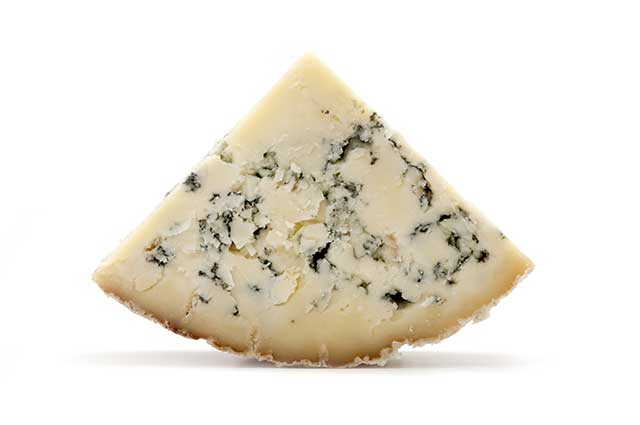
- Country of Origin: England
- Strength: Medium-Strong
- Texture: Semi-hard
- Appearance: Creamy yellow with small blue veins running out from the center
- Calories: 393 kcal
- Carbohydrate: 3.6 g
- Fat: 35.7 g
- Protein: 25.0 g
Blue Stilton is one of the most famous types of cheese from England, and producers now export it around the world.
Stilton has a long and rich history too, and it has played a part in the English diet since the early 18th century.
While the cheese is quite strong and flavorful, it isn’t quite as sharp as other blue cheese varieties, and it has a more mellow taste.
The cheese has some interesting nutrition benefits, and it is an excellent source of vitamin K2.
Stilton provides large amounts of dietary fat and protein, and it contains 393 calories per 100 grams (48).
See this full guide to Stilton for more information.
45. String Cheese
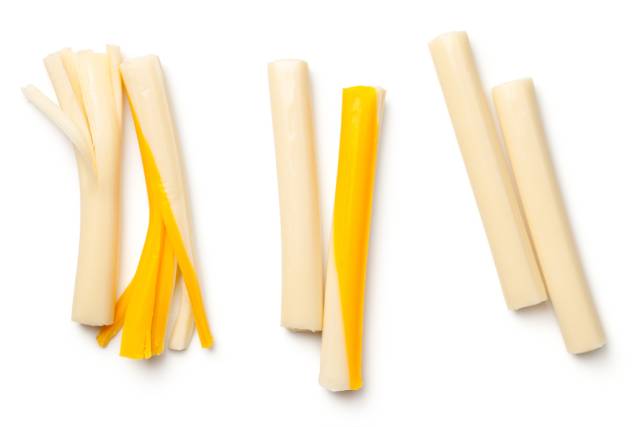
- Country of Origin: United States
- Strength: Mild
- Texture: Soft, chewy
- Appearance: Light cream to orange
- Calories: 295 kcal
- Carbohydrate: 5.6 g
- Fat: 19.8 g
- Protein: 23.8 g
Like other cheese products like cream cheese, string cheese undergoes more significant processing than regular cheese.
Calculated per 100 grams, string cheese would offer 295 calories and high amounts of fat and protein (49).
However, the extent of processing doesn’t always influence the respective health properties of food.
In the case of string cheese, it is very similar nutritionally to regular cheese.
The minimal manufacturing process requires only heat treatment and no extra ingredients.
String cheese usually comes from Mozzarella cheese, and there is a complete guide to string cheese here.
46. Taleggio
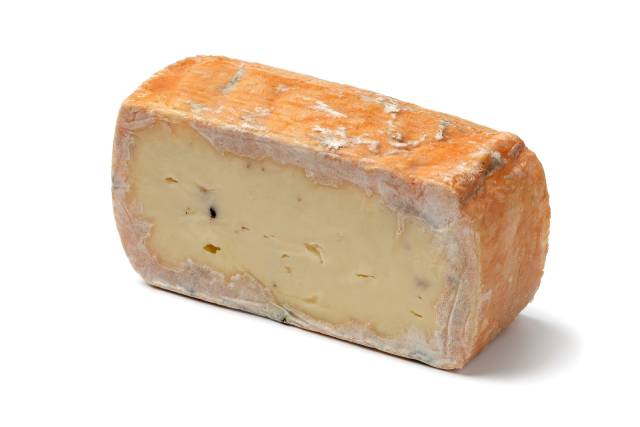
- Country of Origin: Italy
- Strength: Mild
- Texture: Semi-hard
- Appearance: Pale yellow with a pink, salmon-like rind
- Calories: 286 kcal
- Carbohydrate: 0 g
- Fat: 25.0 g
- Protein: 17.9 g
Taleggio is an aged Italian semi-soft cheese with some unique characteristics.
For one thing, the cheese has a pungent smell, and the taste of the cheese has fruity and nutty tones.
Despite the aroma of Taleggio, it has a mild and creamy texture and does not taste too strong.
Taleggio melts well, and it works in a range of foods, from salads and cheese platters to being crumbled on top of dishes.
Per 100 grams, Taleggio has 286 calories, and it is moderately high in protein and fat (50).
47. Tilsit
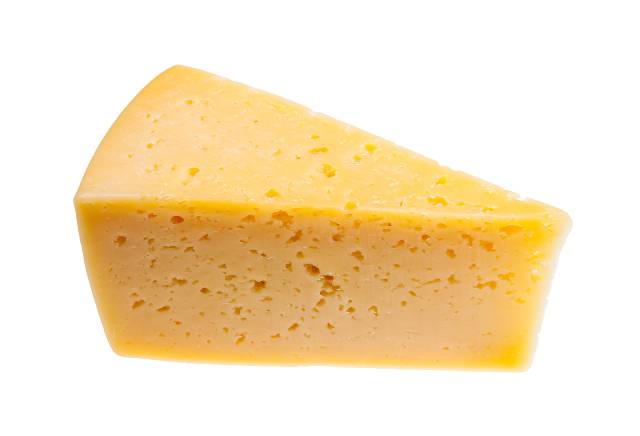
- Country of Origin: Prussia (now Russia)
- Strength: Mild, slightly spicy
- Texture: Semi-hard
- Appearance: Pale yellow, smooth, contains holes
- Calories: 340 kcal
- Carbohydrate: 1.88 g
- Fat: 26.0 g
- Protein: 24.4 g
Tilsit is a mild-flavored, semi-hard cheese with origins in what is now Kaliningrad Oblast, Russia (formerly Prussia) (51).
The cheese has a smooth texture and a holey surface similar to some Swiss cheese varieties.
Although relatively mild, the cheese has added flavorings from peppercorns and caraway seeds that give the cheese a bit of spice.
In addition to tasting great by itself, Tilsit can also be melted into cooked dishes or used as a topping on foods.
100 grams of Tilsit provides 340 calories and moderate amounts of protein and fat (52).
48. Vegan Cheese
There is no single ‘vegan cheese,’ and this name refers to a group of cheese-like products made from plants rather than dairy.
Over recent years, a wide range of plant-based cheese options has appeared on store shelves. These products aim to give a cheese-like experience without the dairy, but are they achieving their goals?
The answer to this question probably depends on the particular vegan cheese product and upon whom you ask.
However, the consensus appears that plant-based cheeses don’t taste as good as dairy cheese. A systematic review examined consumer thoughts on plant-based cheese and found that only 32% of US consumers felt plant-based cheese tastes as good as regular cheese (53).
Current vegan cheese options tend to use nuts, seeds, oils, and thickening agents as ingredients.
49. Wensleydale
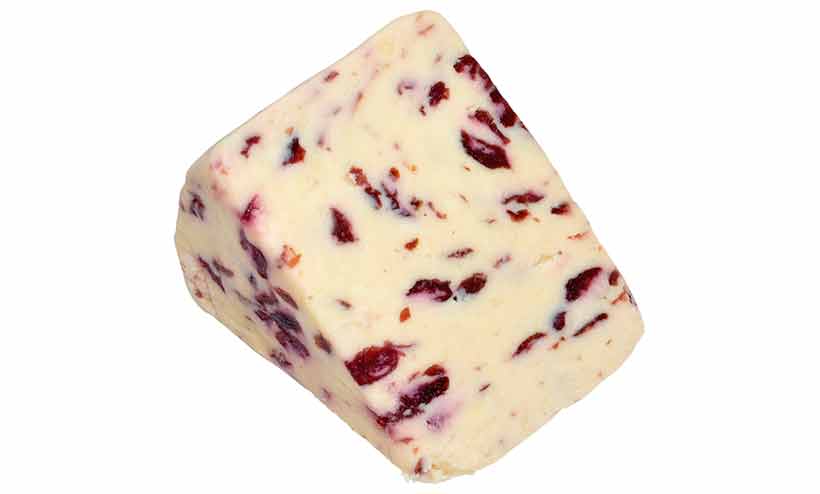
- Country of Origin: England
- Strength: Mild
- Texture: Moist, crumbly
- Appearance: Pale and crumbly
- Calories: 385 kcal
- Carbohydrate: 0.1 g
- Fat: 31.8 g
- Protein: 23.7 g
Wensleydale is a famous British cheese originally from the village of Wensleydale in North Yorkshire, England.
Wensleydale has a white to pale-yellow appearance, and it is a crumbly cheese.
The flavor is somewhat tart, hence it is sometimes combined with fruit to sweeten the overall taste, especially cranberries and apricots.
Although it is available in white and blue versions, white Wensleydale is far more prevalent.
For more information, see this complete nutritional guide to Wensleydale cheese.
Classes of Cheese
We have shown in this guide that there are dozens of different cheese options from around the world, each with its own unique features.
However, many of these cheeses share similar grouped characteristics with other cheese varieties.
This is because we can use several different ‘classes’ of cheese to categorize a particular cheese.
What are these classes?
The International Dairy Federation (IDF) has published a useful factsheet showing the different major classes of cheese and the varying ways cheese can be classified.
To summarize this factsheet, we can use the following characteristics to categorize the different cheese classes:
Firmness, determined by moisture content on a fat-free basis (MFBB %)
A percentage score is given to a cheese after dividing the moisture (water) weight in the cheese by the fat-free weight of the cheese and multiplying by 100.
- Extra hard (<51%): examples include Asiago and Parmesan cheese
- Hard (49-56%): examples include Cheddar and Manchego
- Semi-hard (54-69%): examples include Gouda and Havarti
- Soft: (>67%): examples include Brie and Camembert
Milkfat content, determined by fat content in dry matter (FDM %)
A percentage score is given to a cheese calculated by dividing the weight of the fat content in the cheese by the weight of the cheese minus water content and then multiplying by 100.
- High fat (>60%)
- Full fat (45-60%)
- Medium fat (25-45%)
- Partially skimmed (10-25%)
- Skimmed (<10%)
Cheese that has surface mold
Some cheese varieties have a white surface mold, such as Brie and Camembert. These cheeses tend to have a soft interior underneath the mold.
Cheese with blue mold inside
Numerous popular cheeses have internal blue mold “veins.”
These cheese options include Danish Blue, Gorgonzola, and Stilton.
Brined white cheese
Some varieties of cheese are packed in brine, so they tend to have a very salty taste. Examples of brine-packed cheese include Feta and Halloumi.
Fresh cheese
Fresh cheese is characterized by its soft and creamy texture and a much shorter shelf-life.
It contains more lactose than harder cheese. Some examples of fresh cheese include cottage cheese and cream cheese.
Pasta filata cheese
The ‘pasta filata’ production method involves bathing cheese curds in hot water, and then stretching them. Cheese made by this production method tends to have a more elastic and stretchy feel. Mozzarella is an example of a cheese made by this method.
Smear-ripened cheese
Smear-ripened cheese production involves adding a bacterial yeast culture to the surface of the cheese. This has the effect of ripening the cheese from the outside.
Other categories
Some other cheese classes include cheese made by propionic acid fermentation (Jarlsberg) and cheese made by lactic acid bacterial enzymes, such as Cheddar.
We could also categorize based on which animal the milk used to make the cheese came from. For example, goat’s cheese and cow’s cheese are different categories.
Common Questions About Cheese
Here are some answers to commonly asked questions about cheese.
There are many popular cheese varieties, but some of the most popular include Cheddar, Mozzarella, Swiss cheese, Parmesan, and American cheese. According to a 2021 poll of 8815 US adults, 19% answered that Cheddar was their favorite cheese. American cheese was in second place with 13% of the votes, and Mozzarella was third with 9% (54).
There are low-fat varieties of many kinds of cheese, including Cheddar, Colby Jack, cottage cheese, Edam, Gouda, Mozzarella, and more. Most large grocery stores will stock at least one variety of reduced-fat cheese.
This will entirely depend upon taste preferences. However, having a range of different flavors is always a good idea. This can be achieved by including several categories of cheese such as soft cheese (Camembert), semi-hard cheese (Cheddar), and blue cheese (Danish Blue).
There are thousands of types of cheese worldwide, if not more. With all the different cheese classes, regional cheeses, and local recipes, it is hard to state an exact number.
The “best cheese” is very subjective and depends on the individual. However, most cheese options are nutritionally beneficial and contain many nutrients. In short, the “best cheese” is simply the one you enjoy the most.



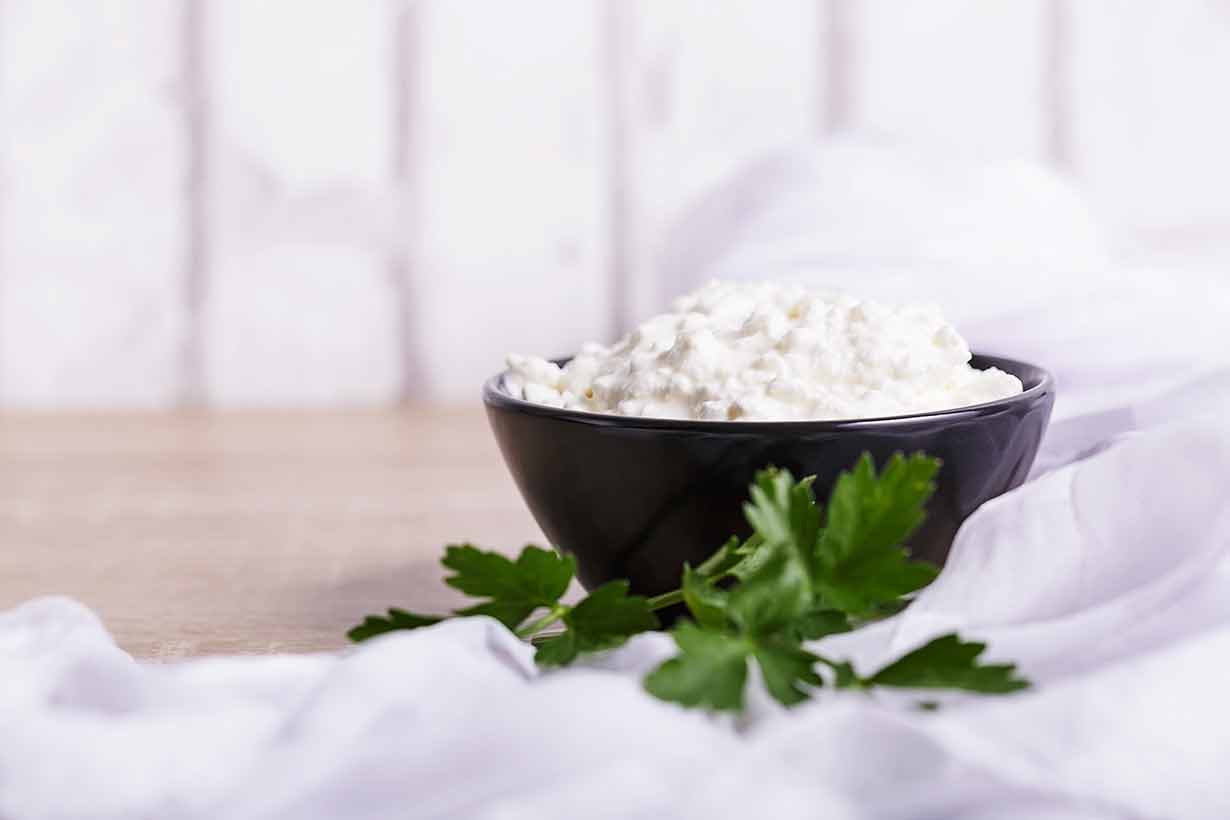
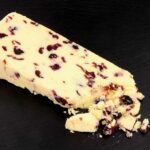
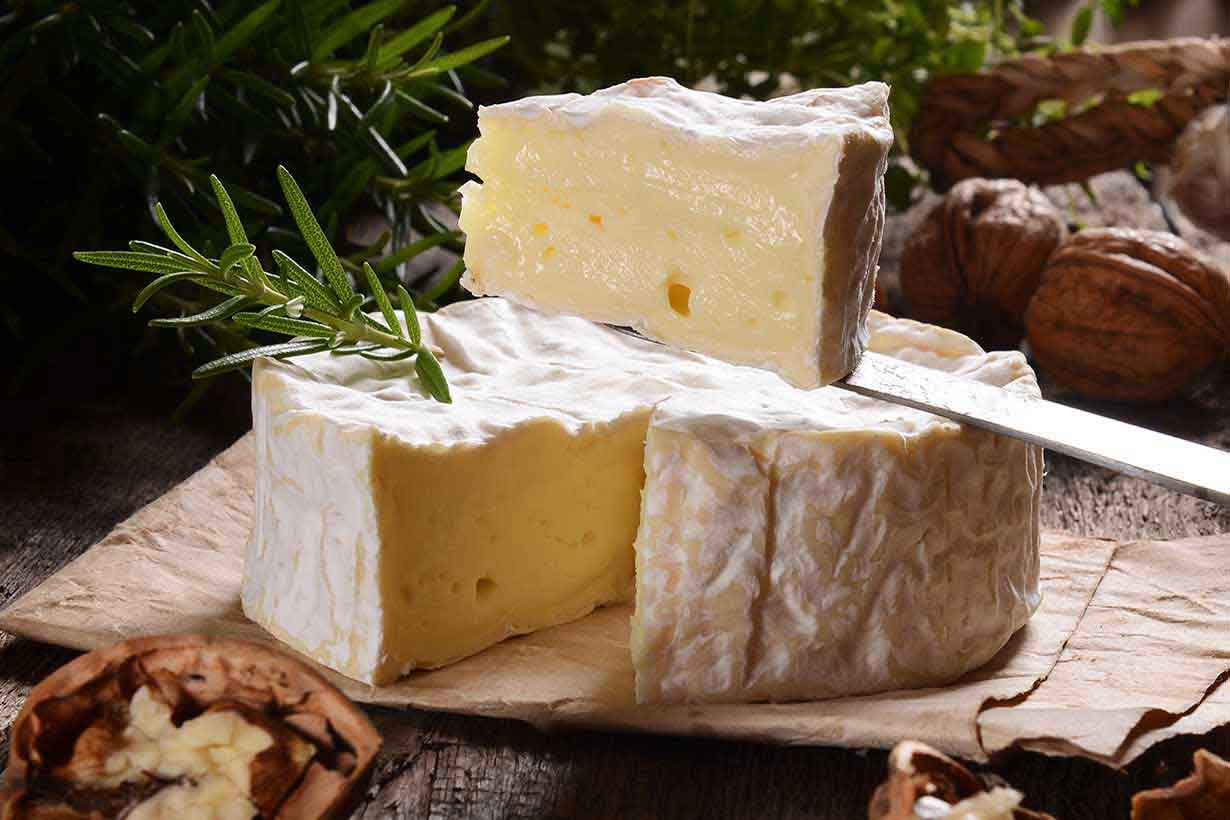
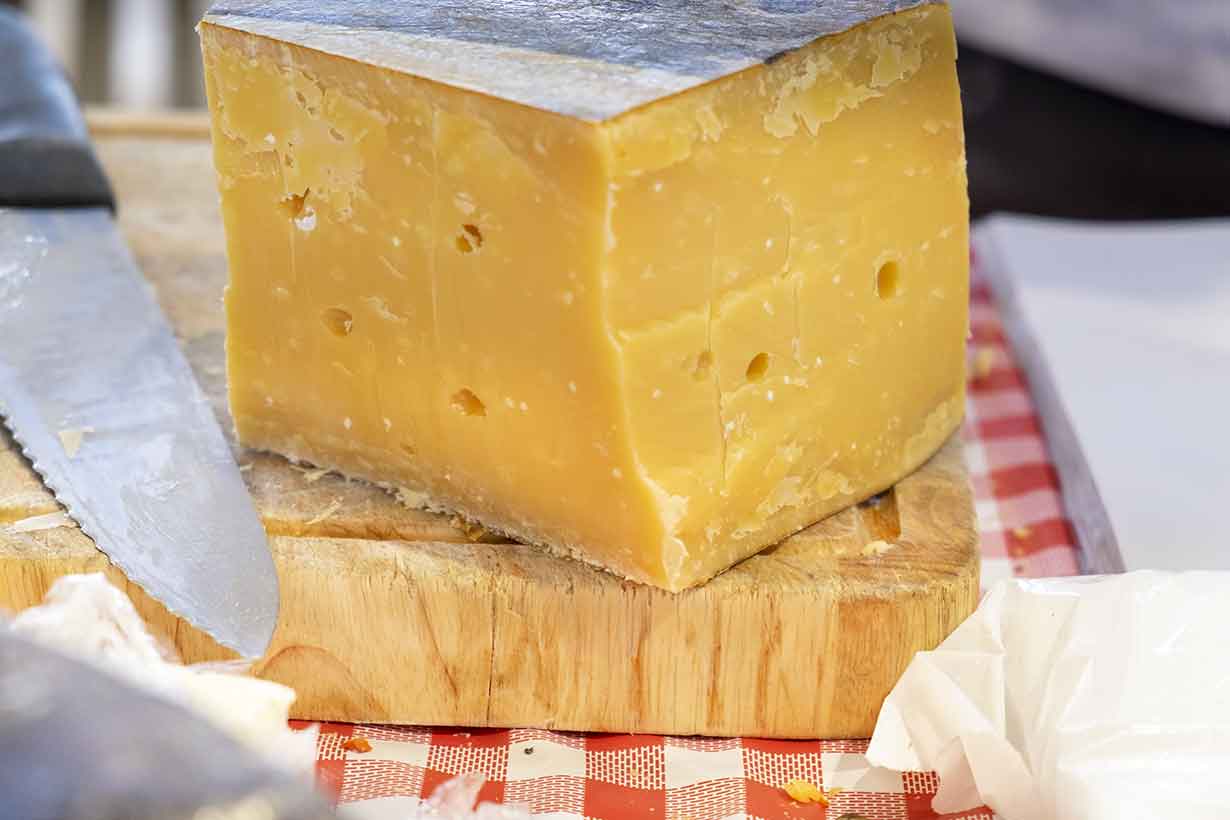
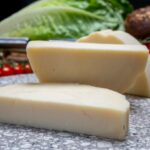
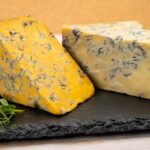
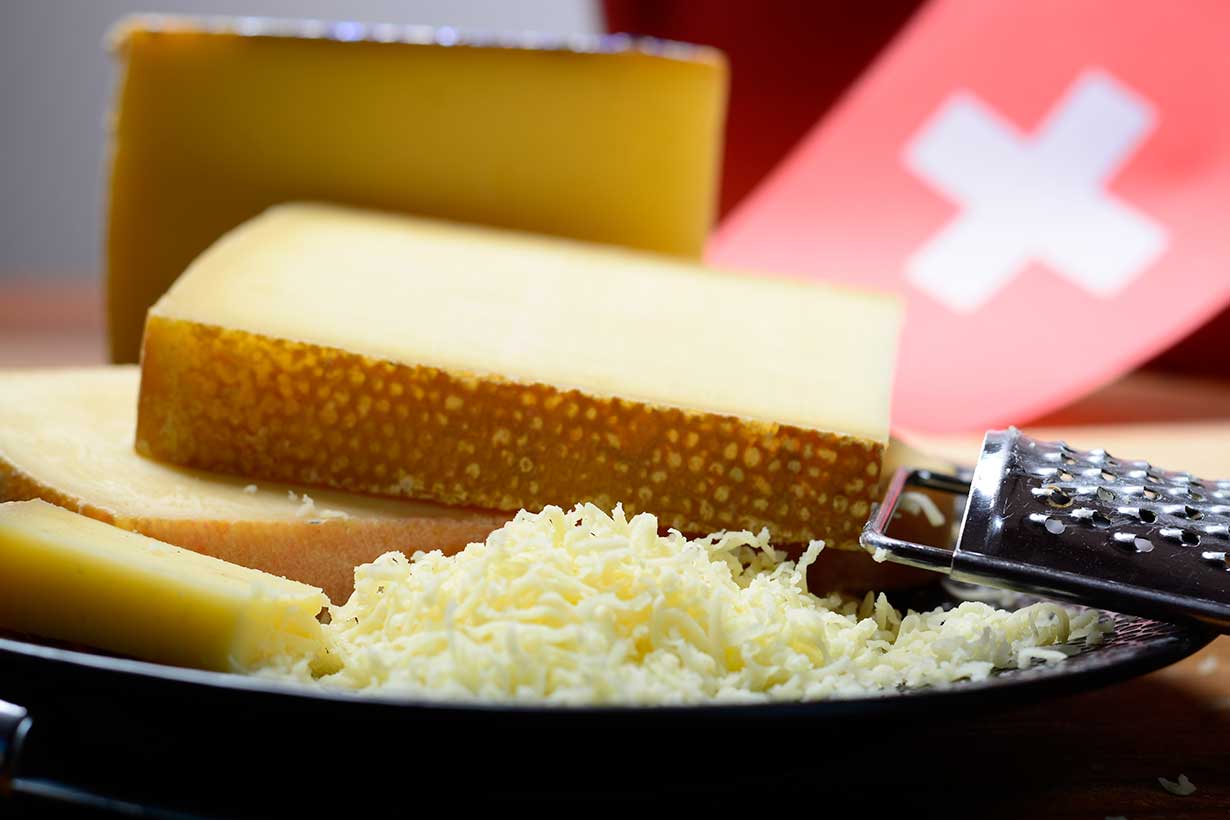
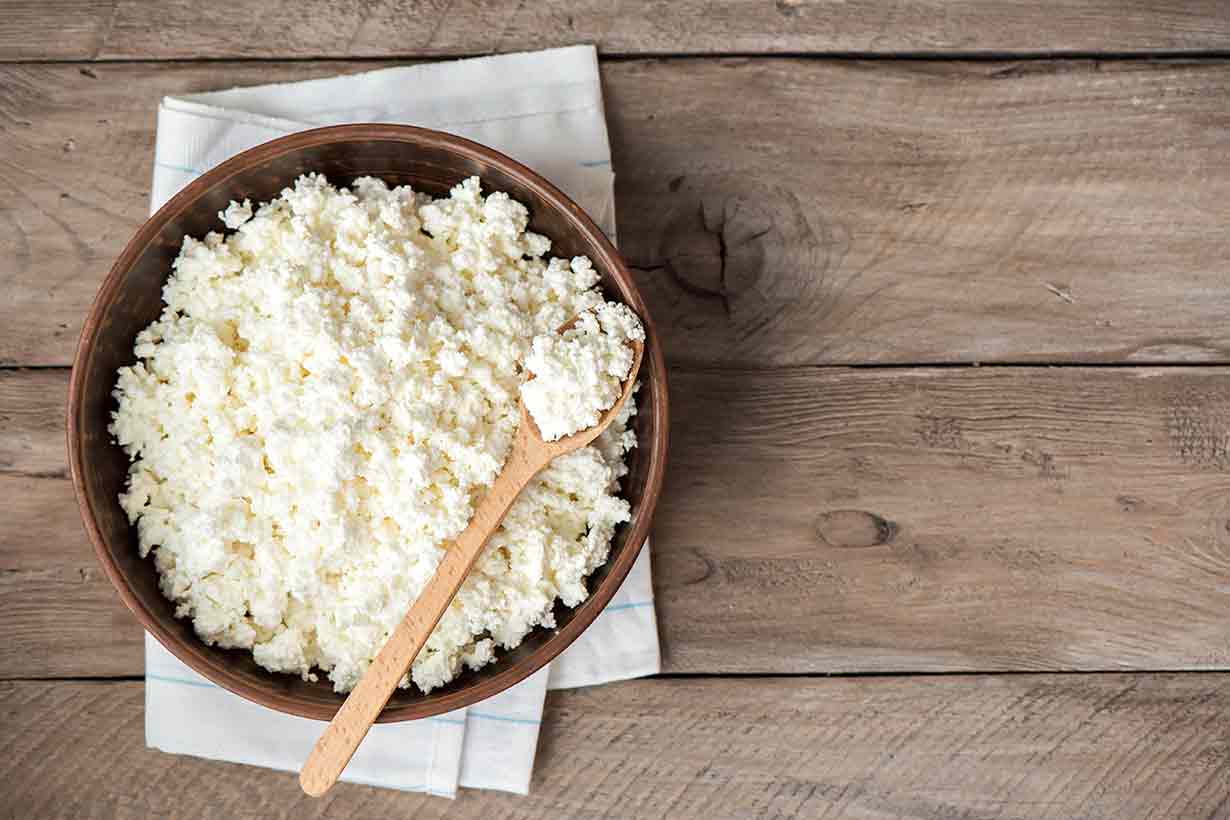
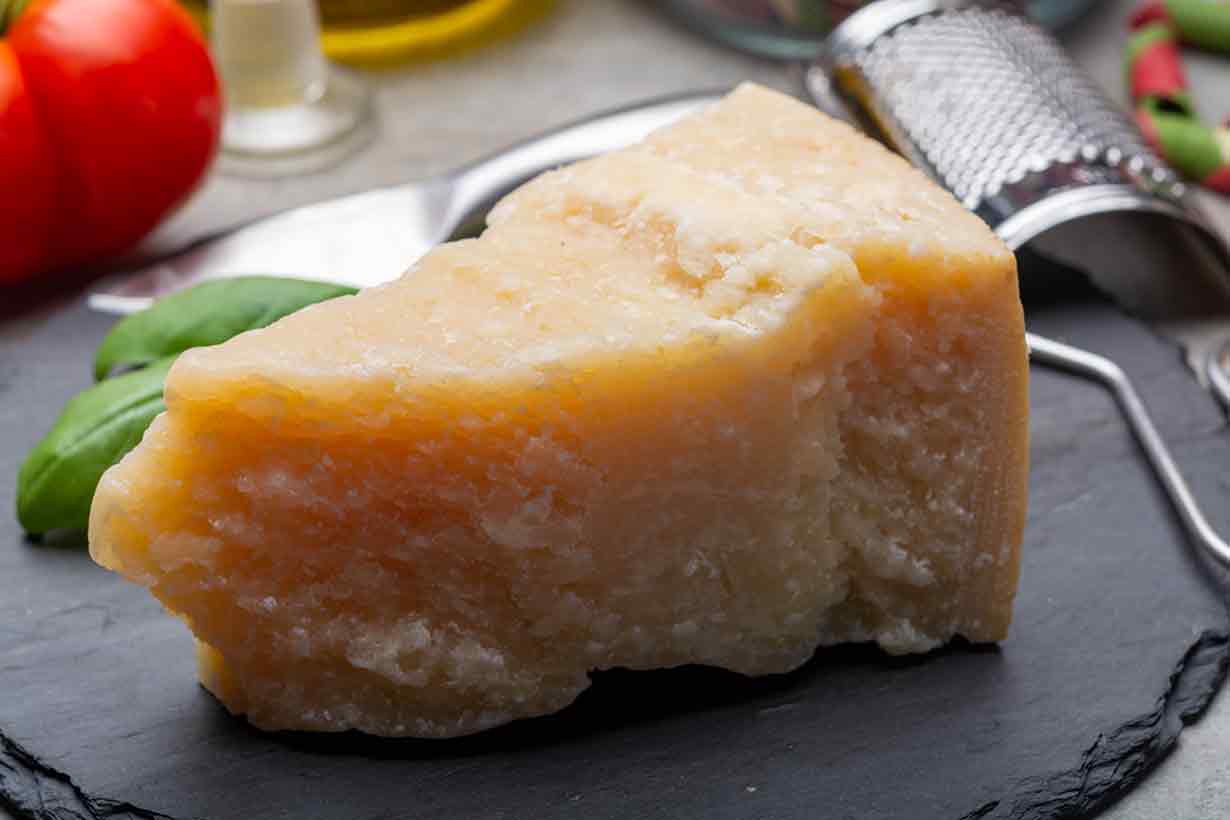
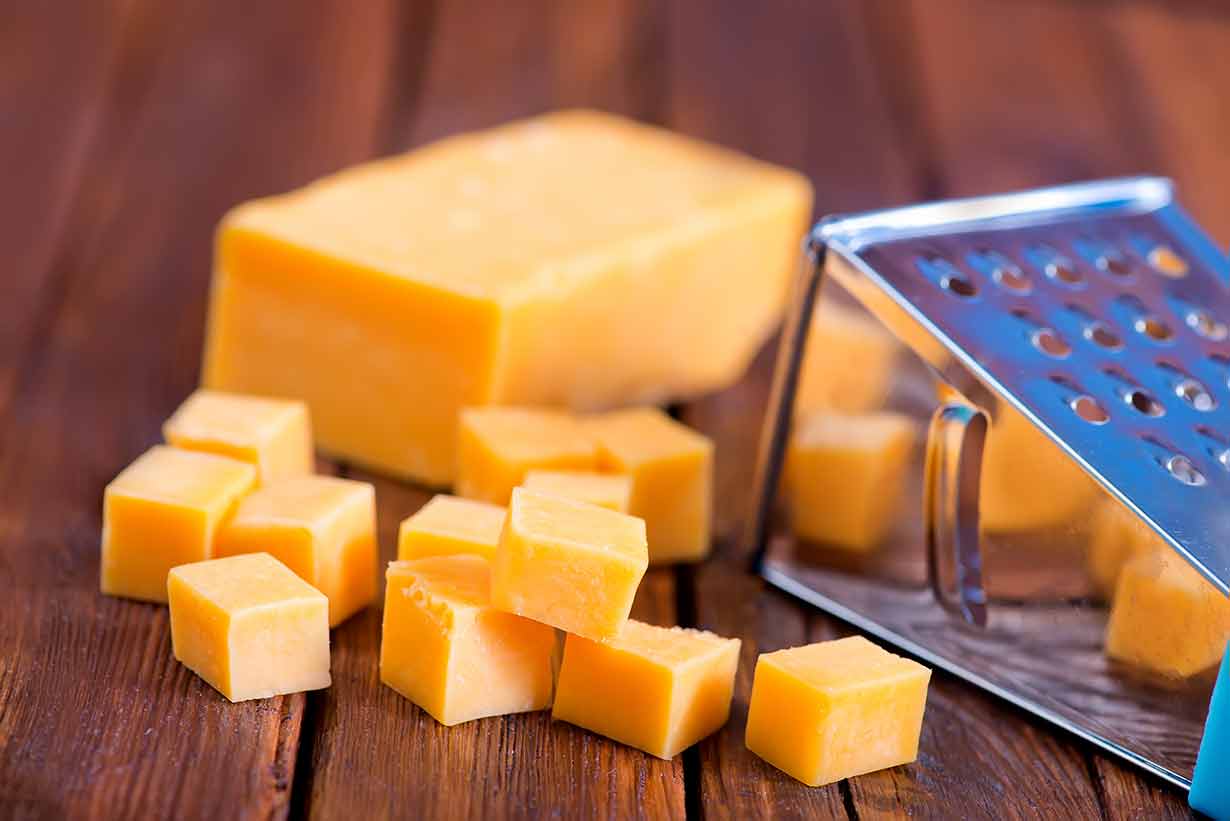
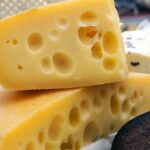
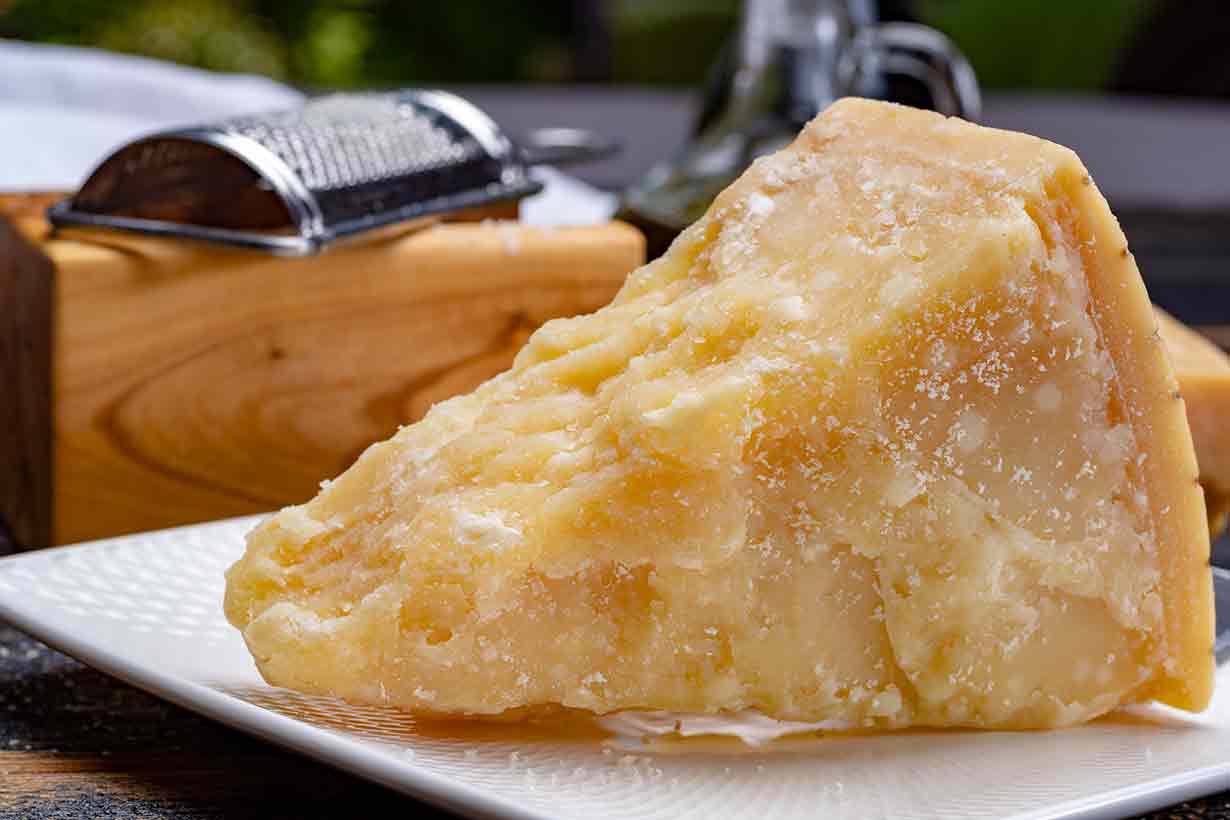
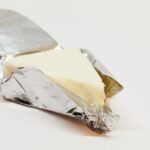
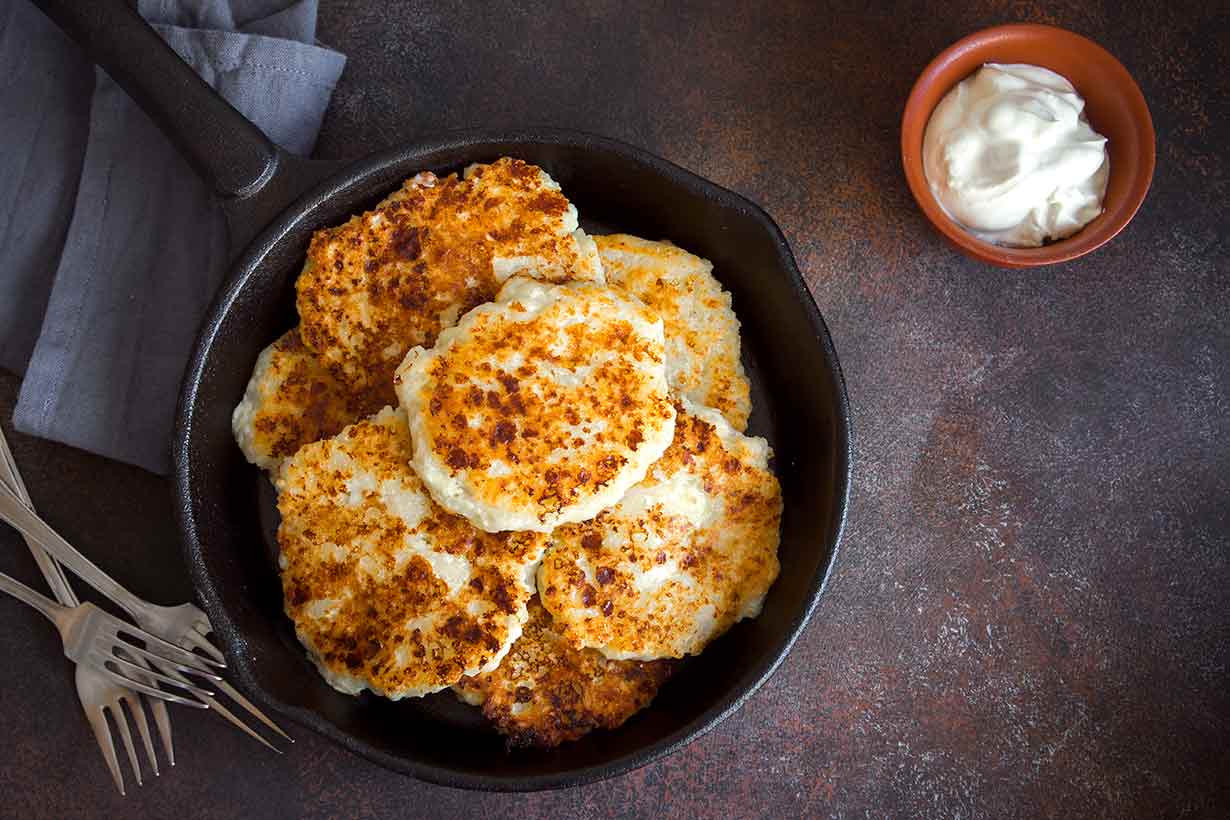
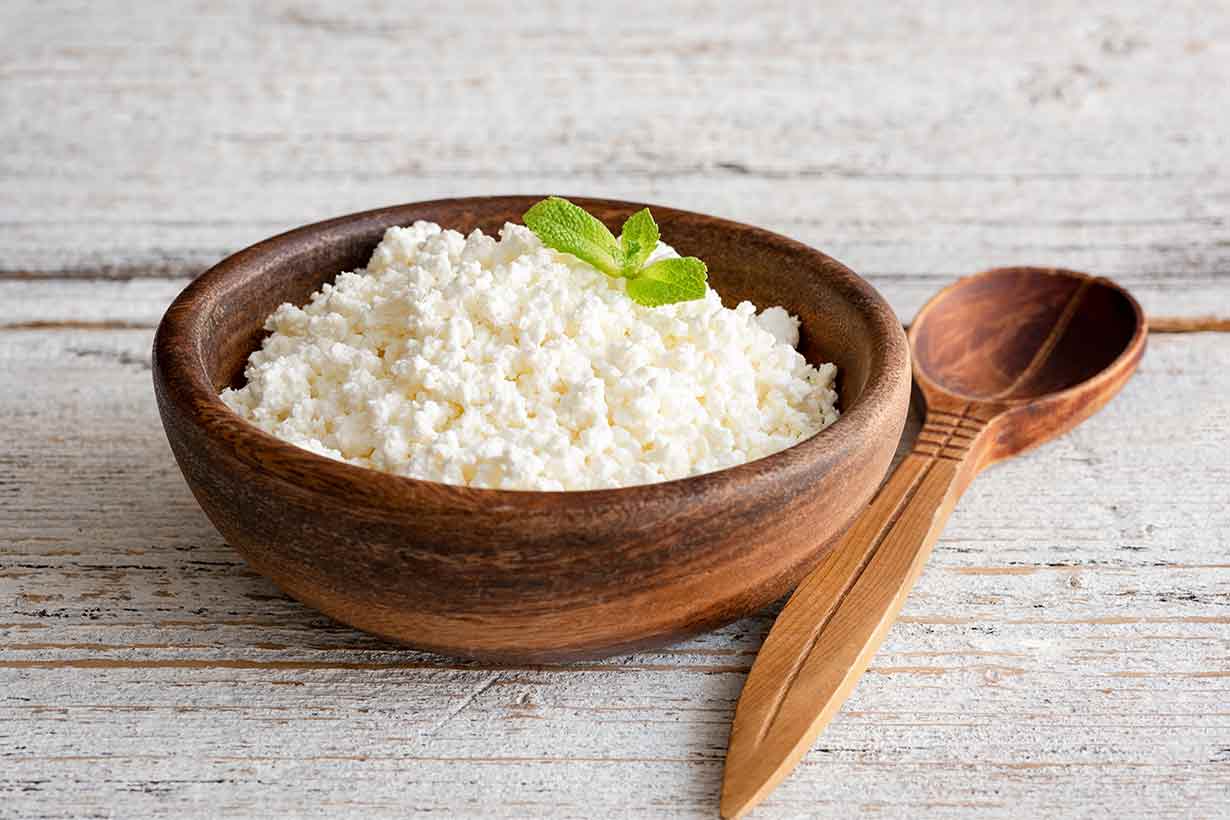
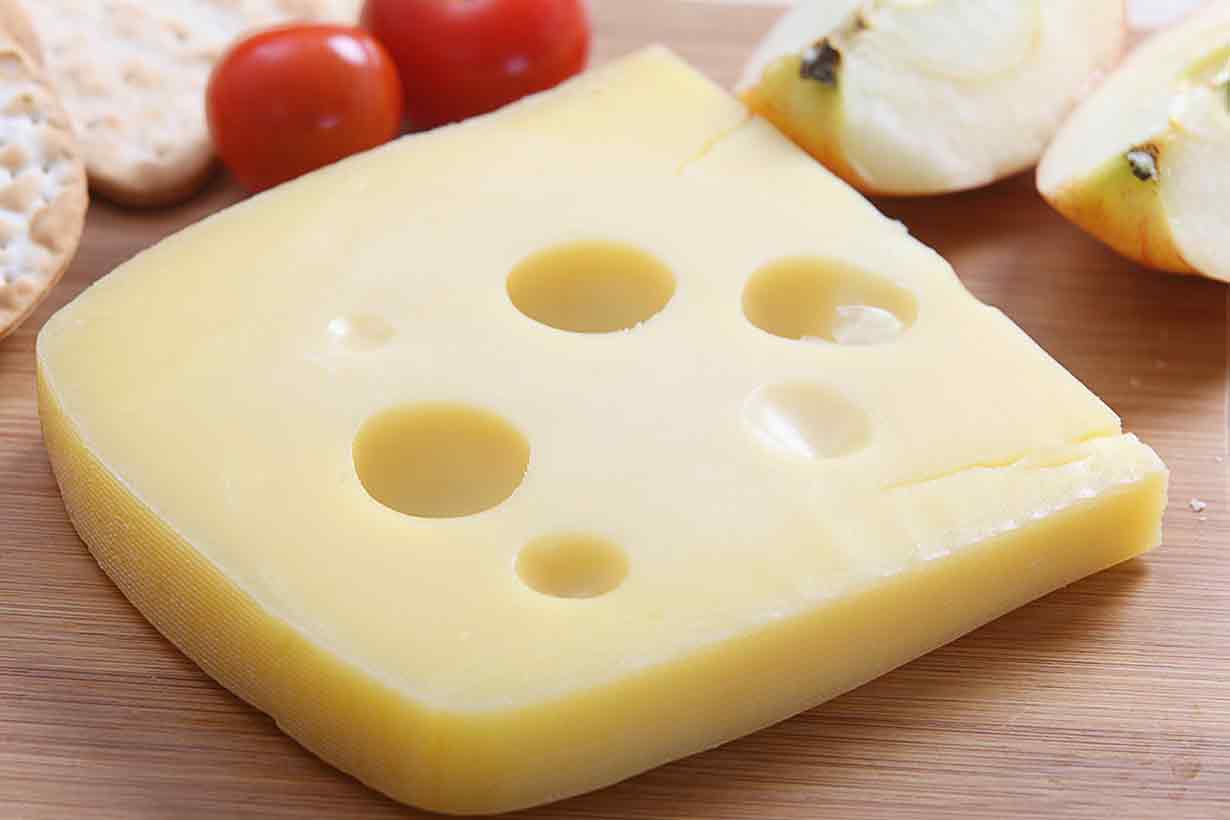
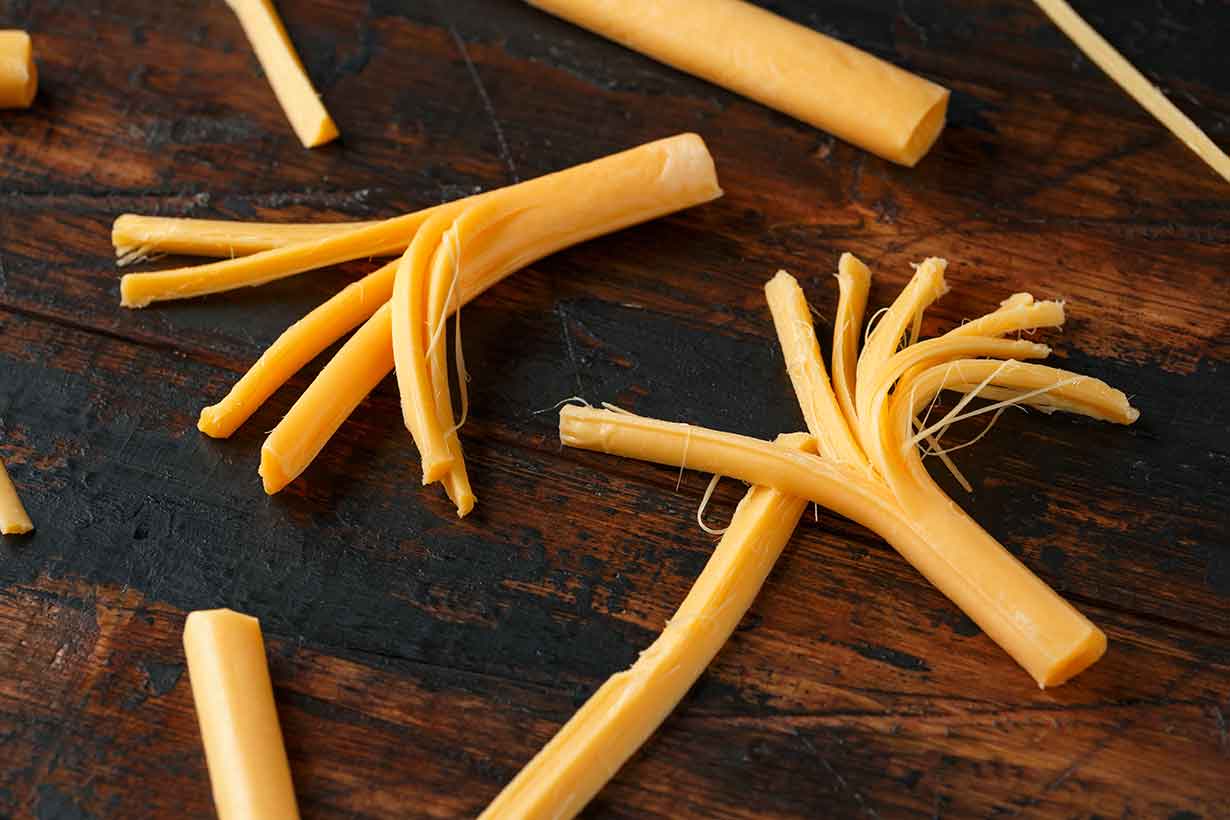

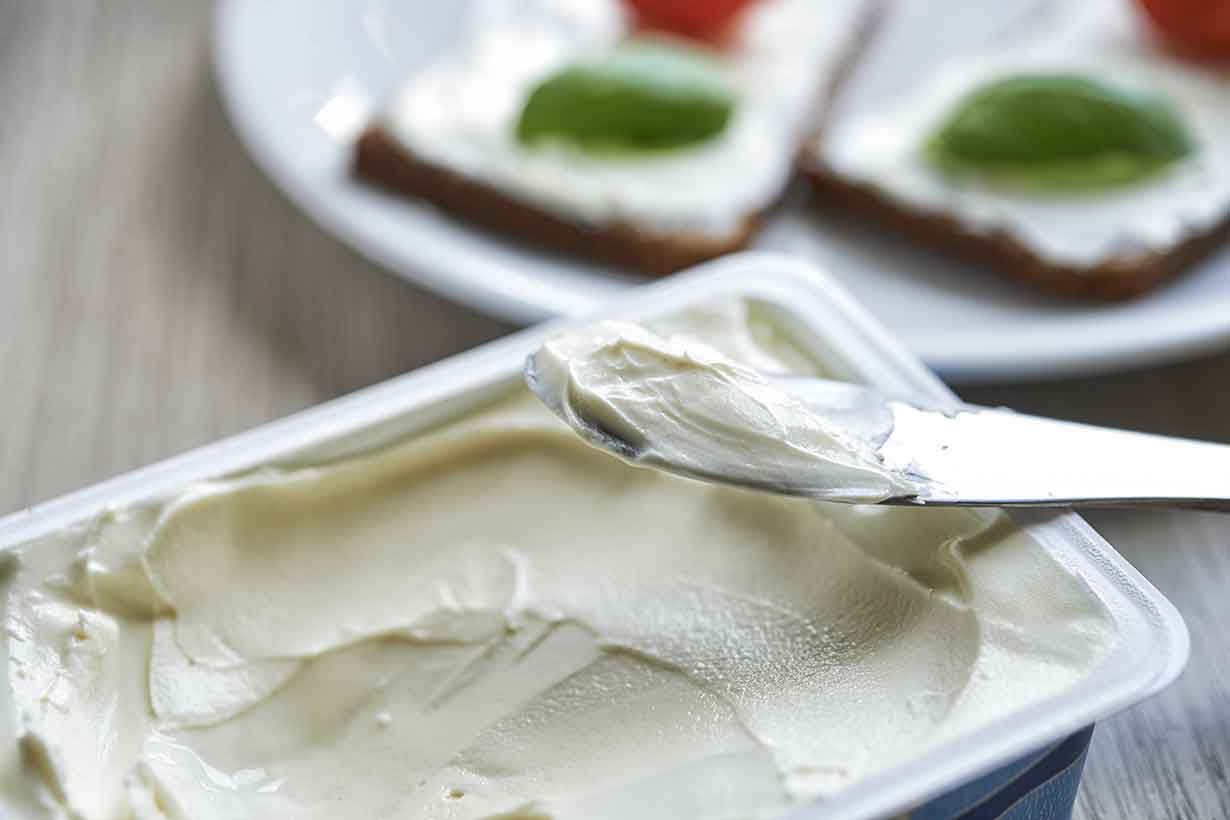
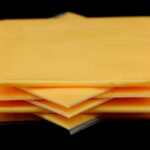

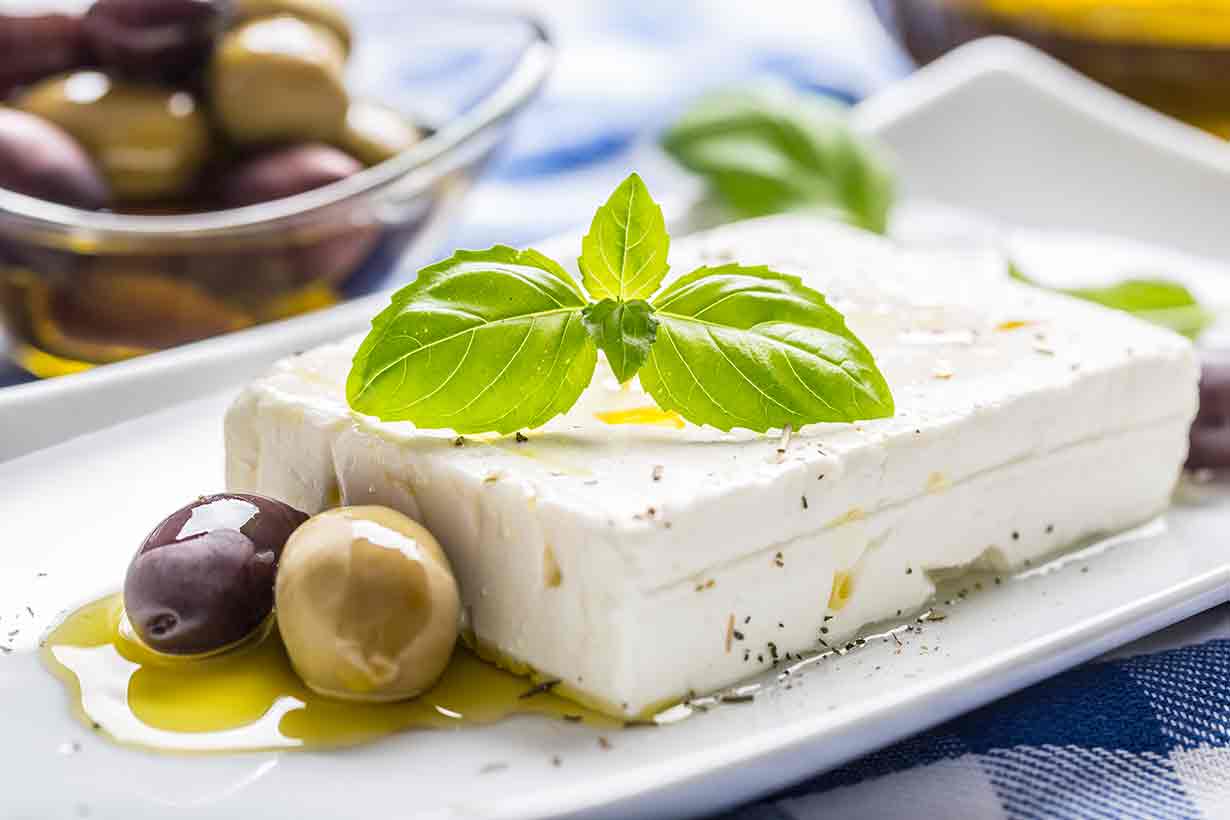
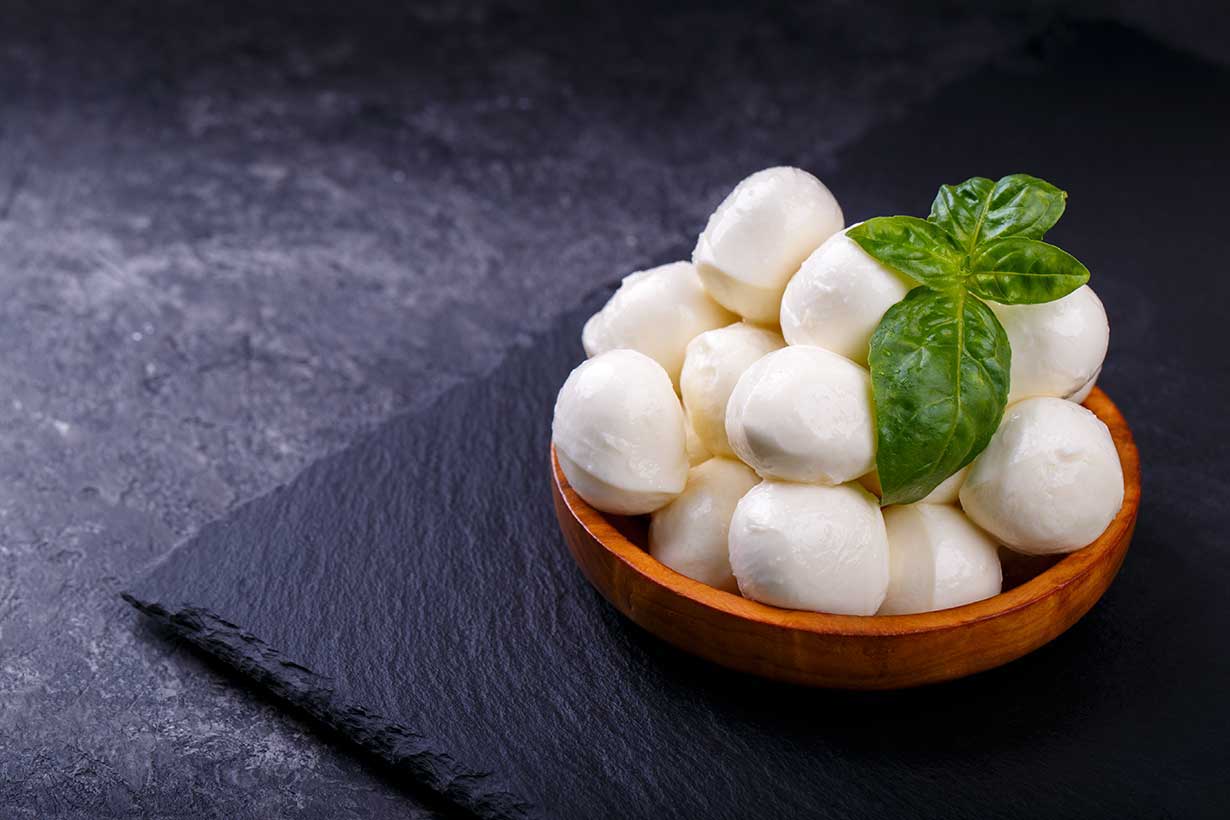
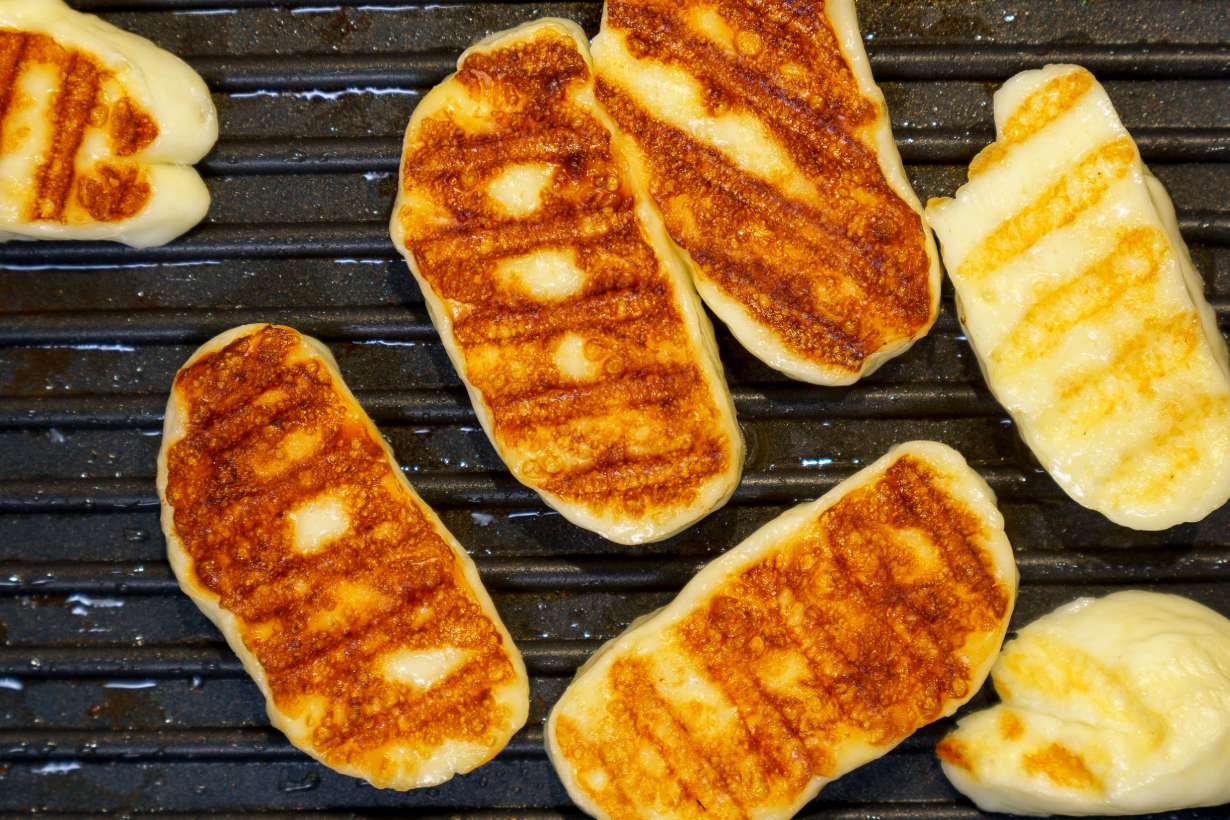
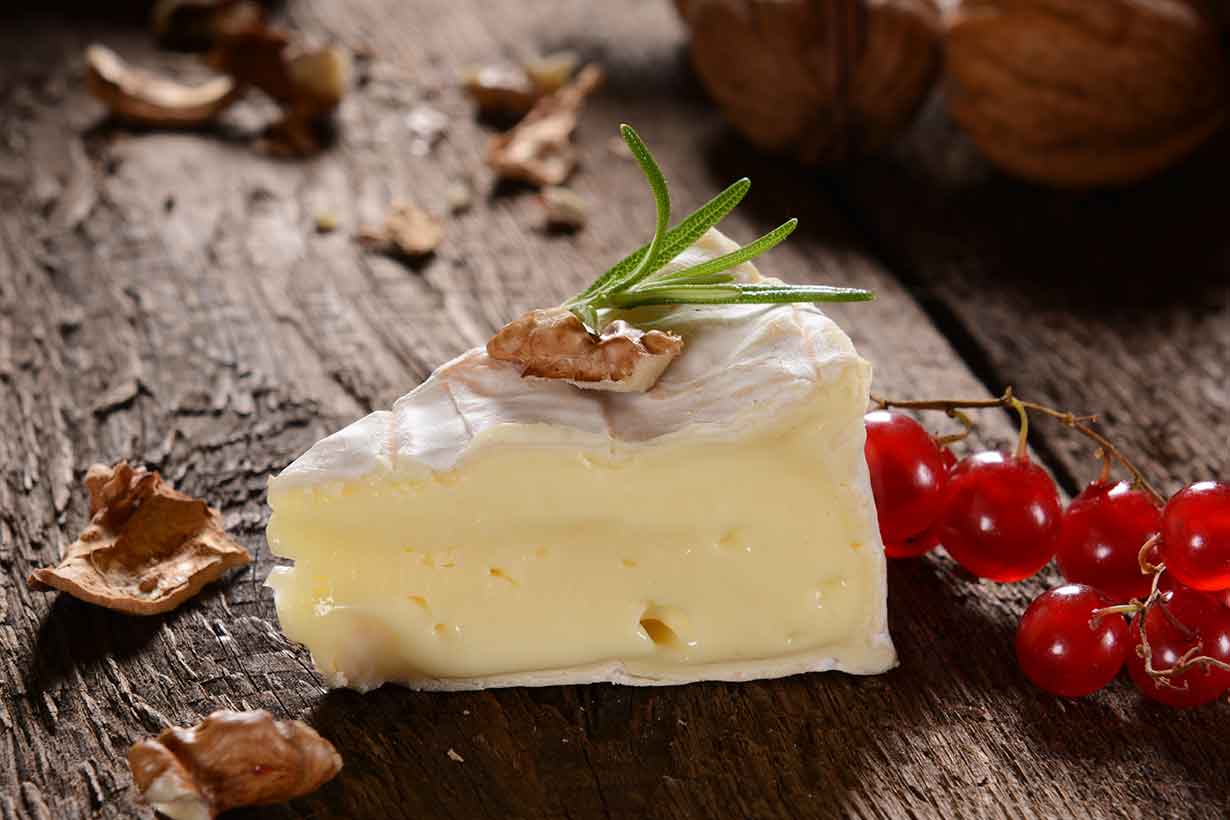

As a cheese lover, this was immensely enjoyable to read. Thank you for this guide. However, although you listed Epoisses and other cheeses I’ve never heard of, you left out Emmenthal and Edam, common cheeses found in most supermarkets, at least in my part of the world. Anyway, kudos for a great article!
Thank you and those are good points. I will try to fit those others (and a few more) in when I get chance!